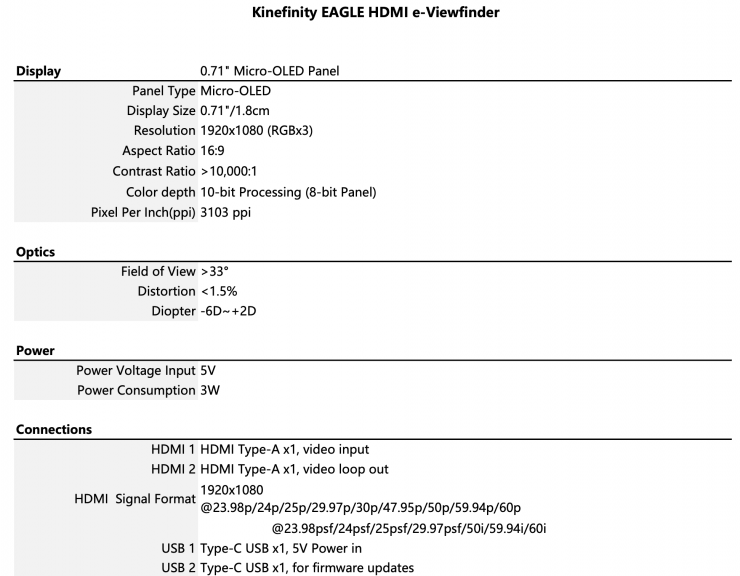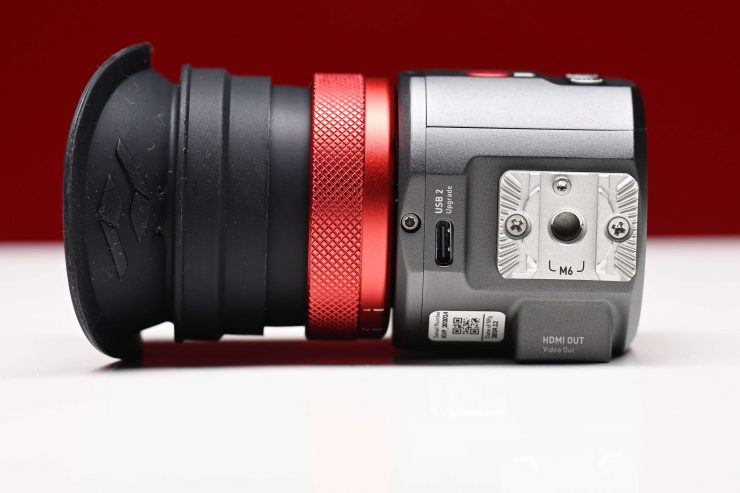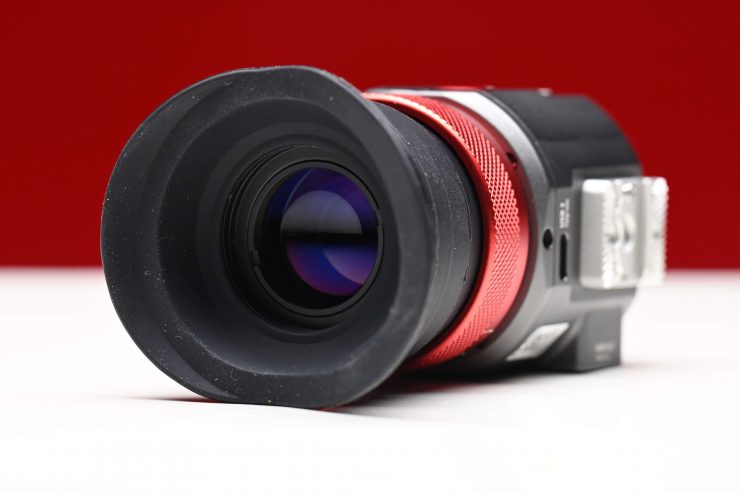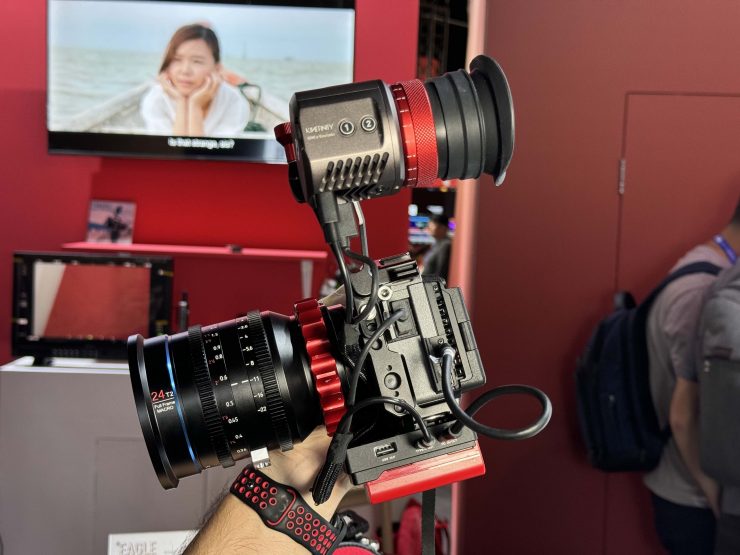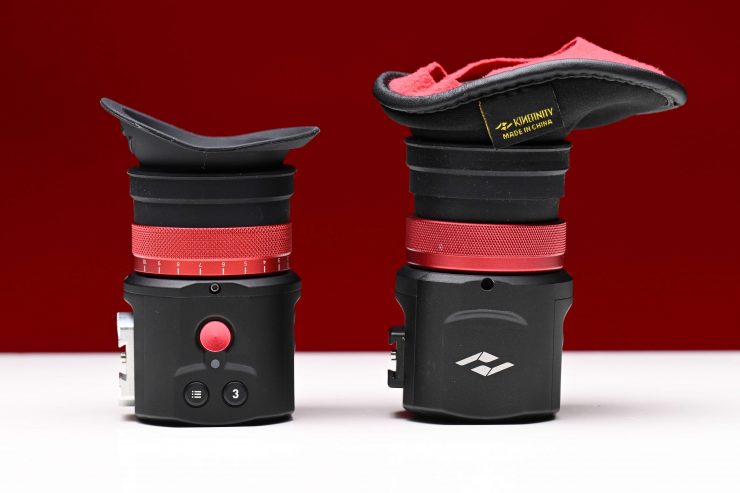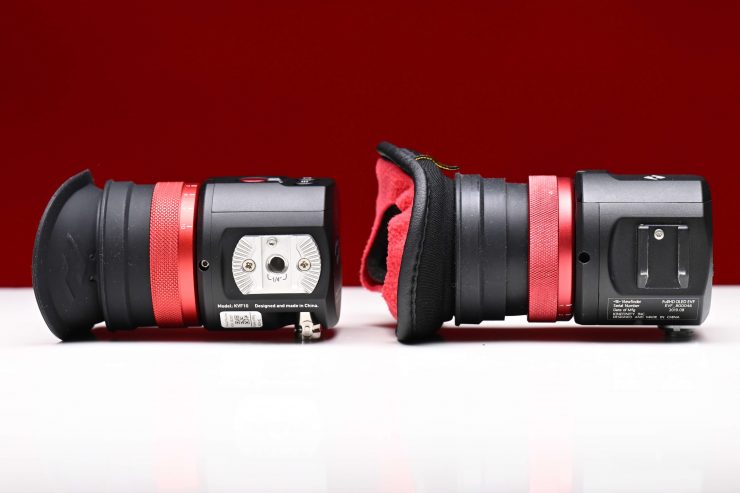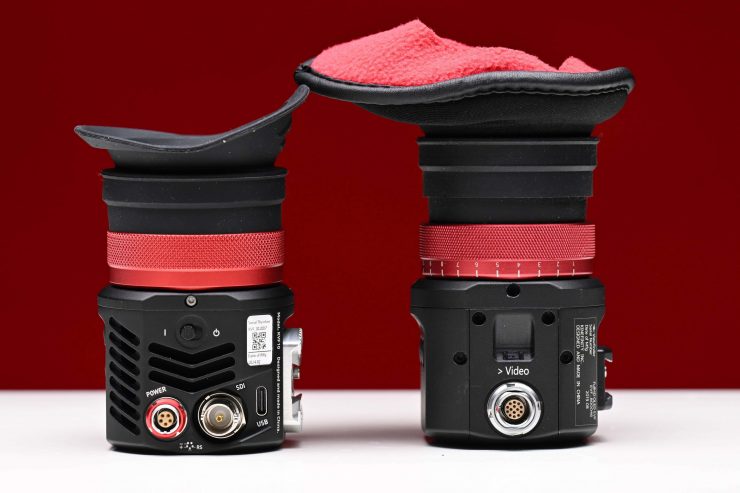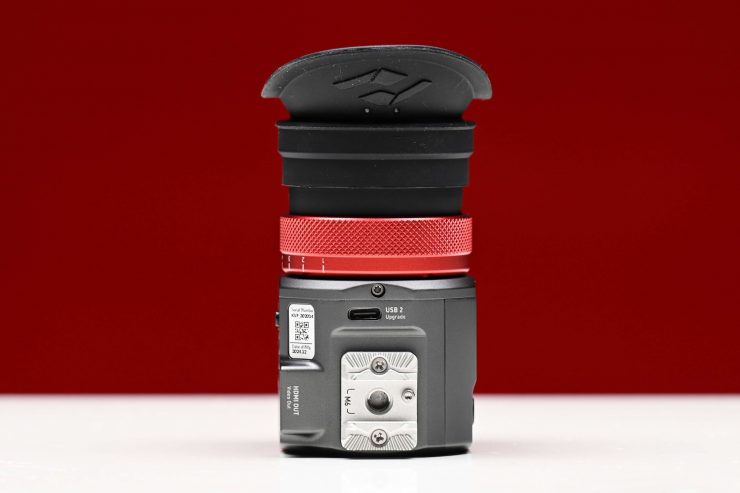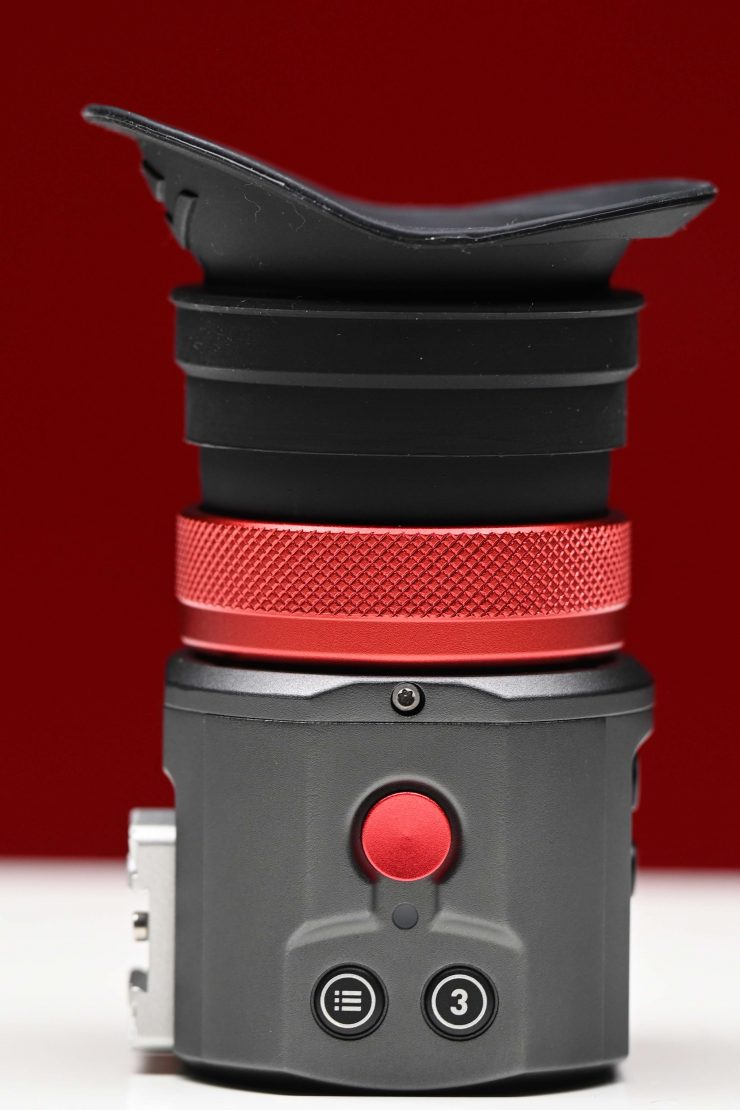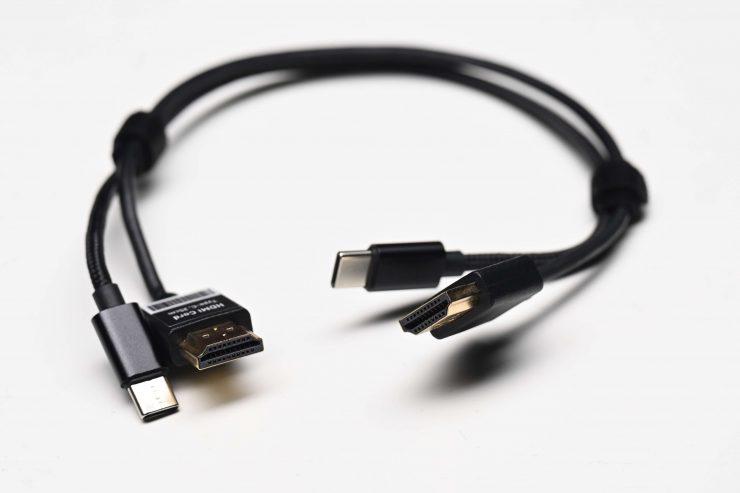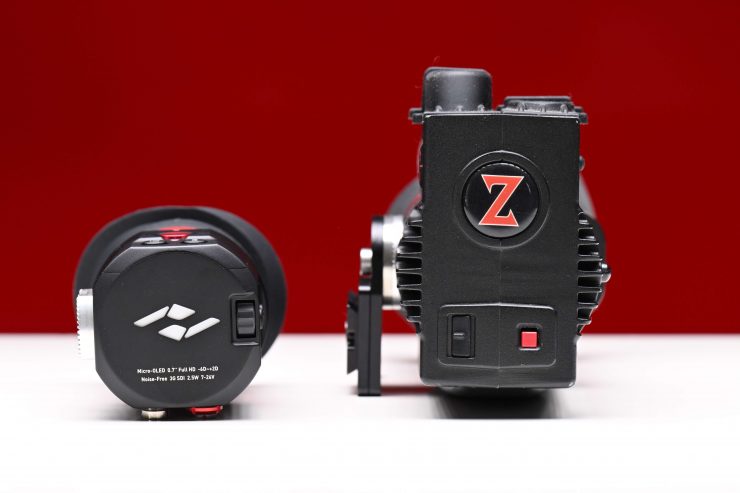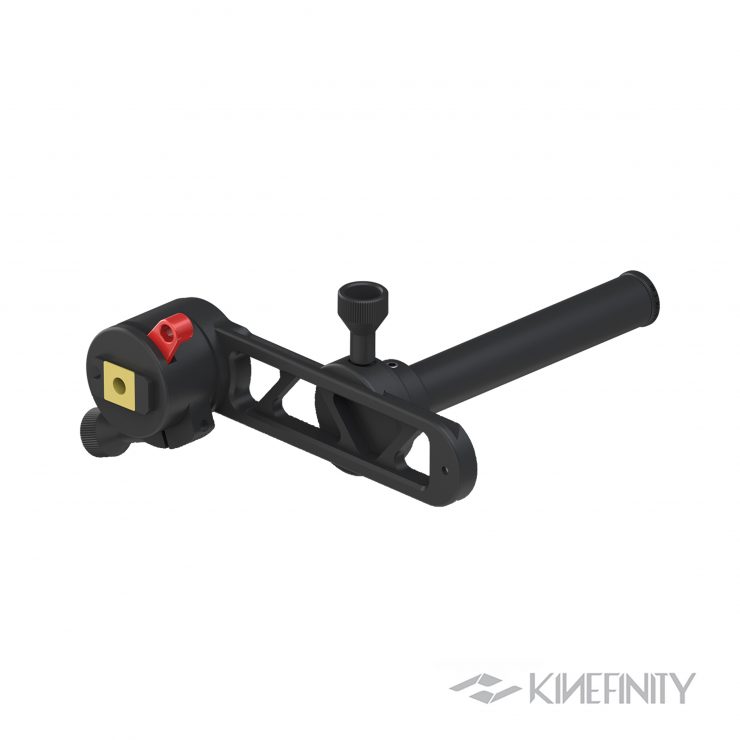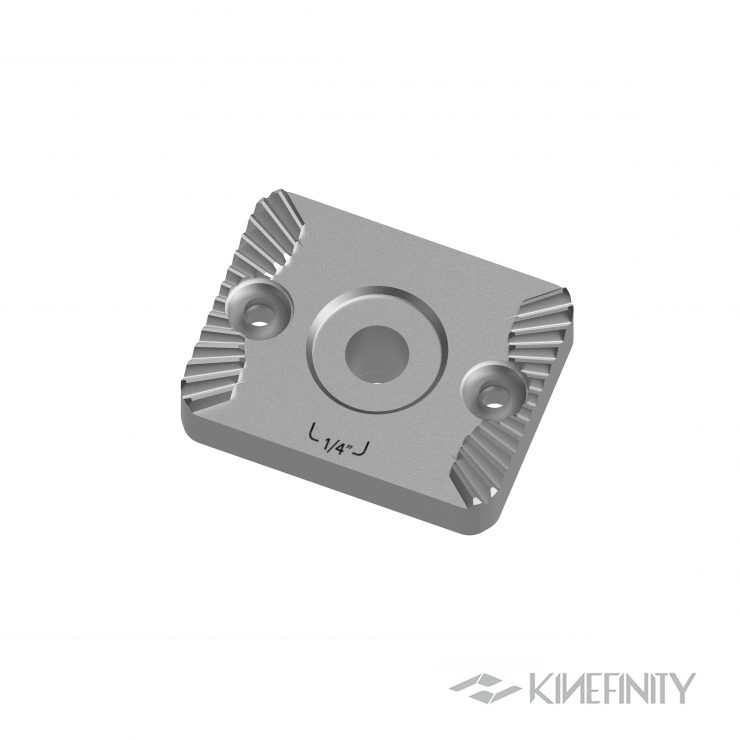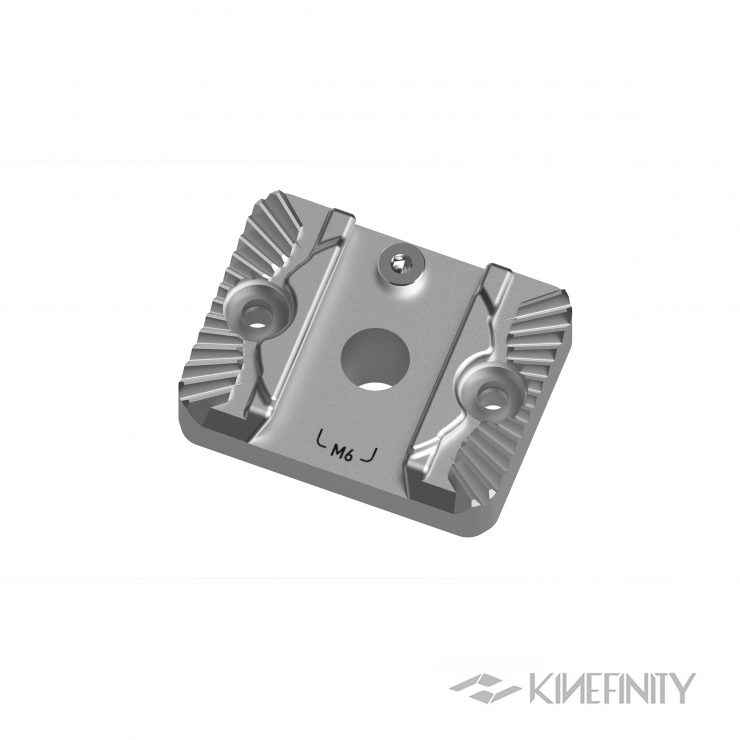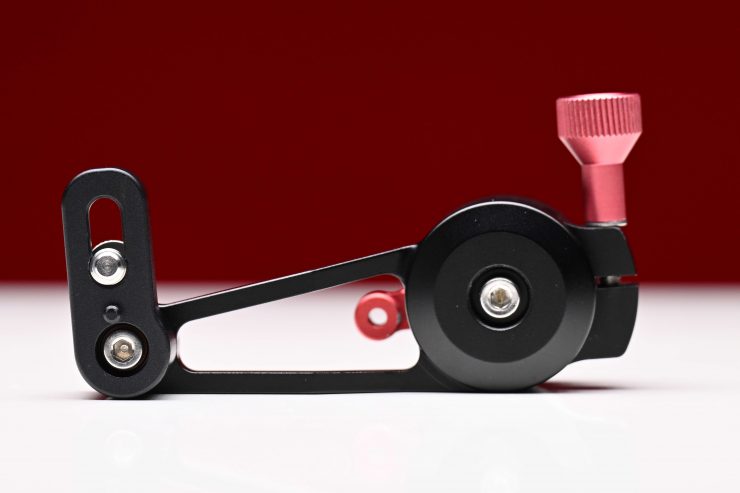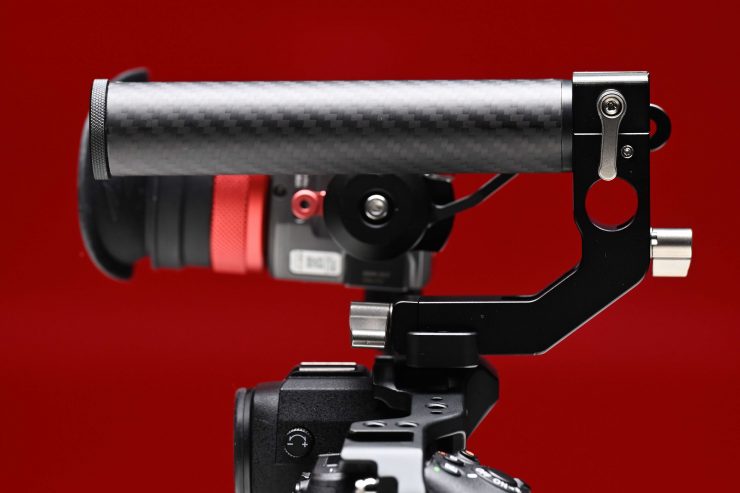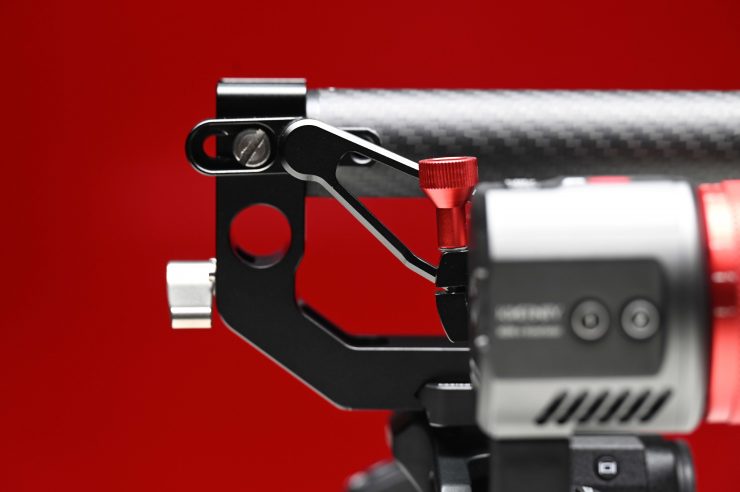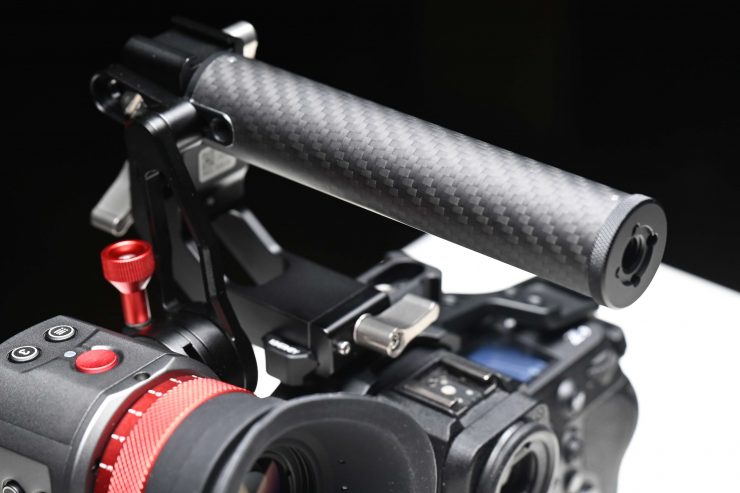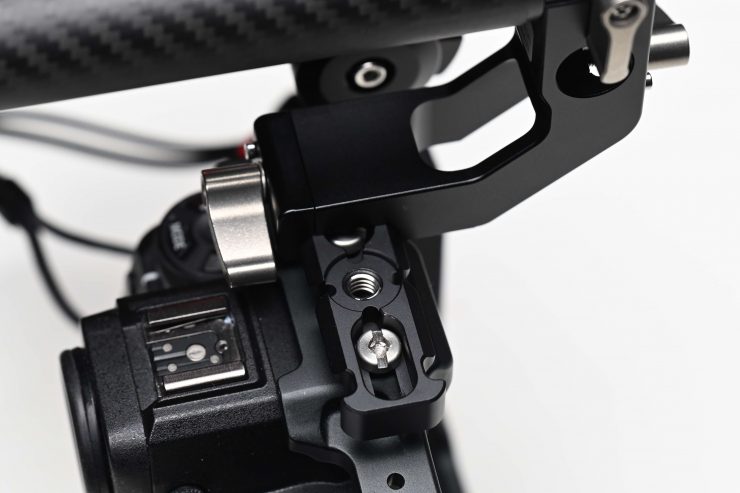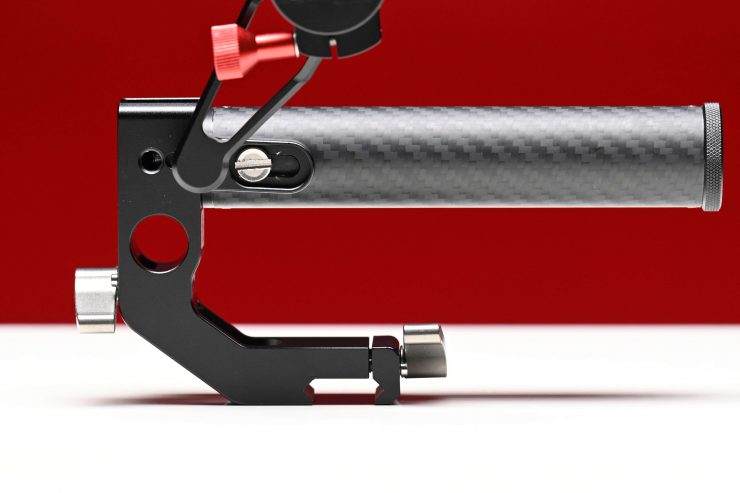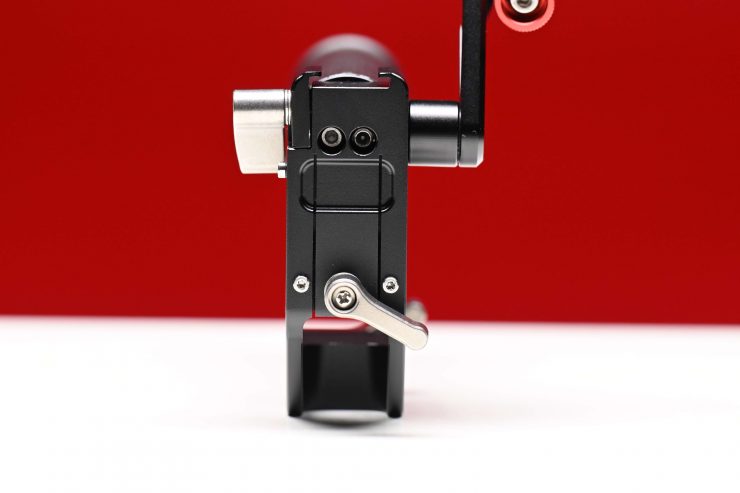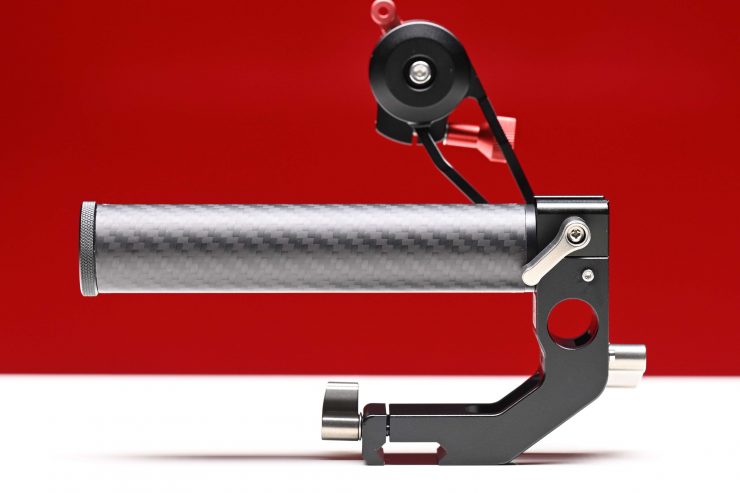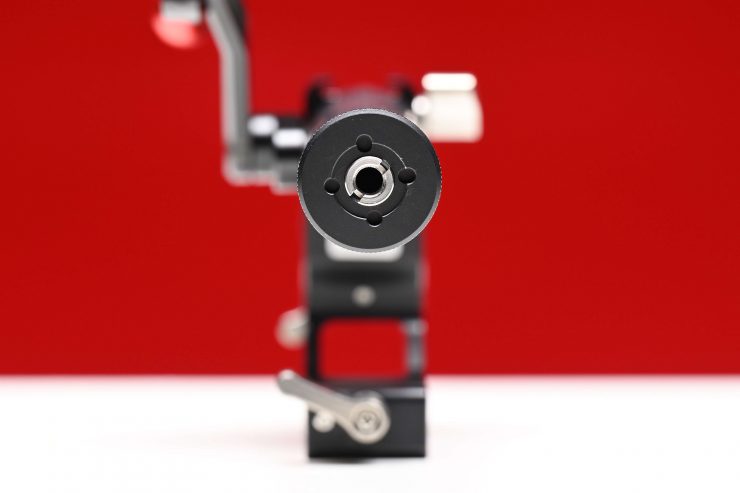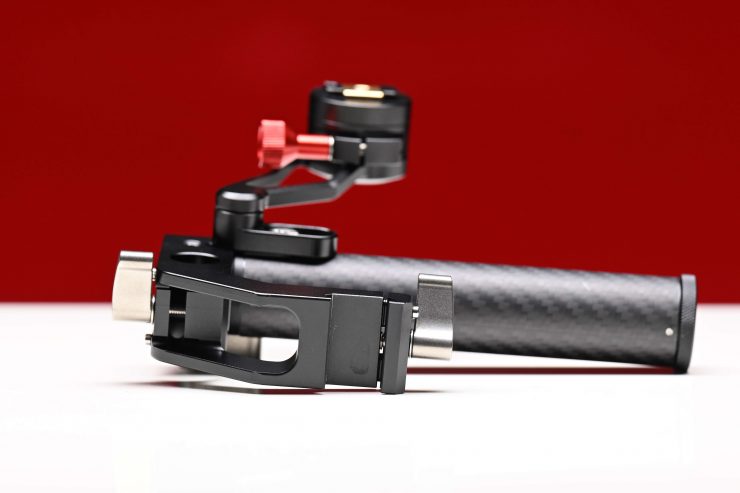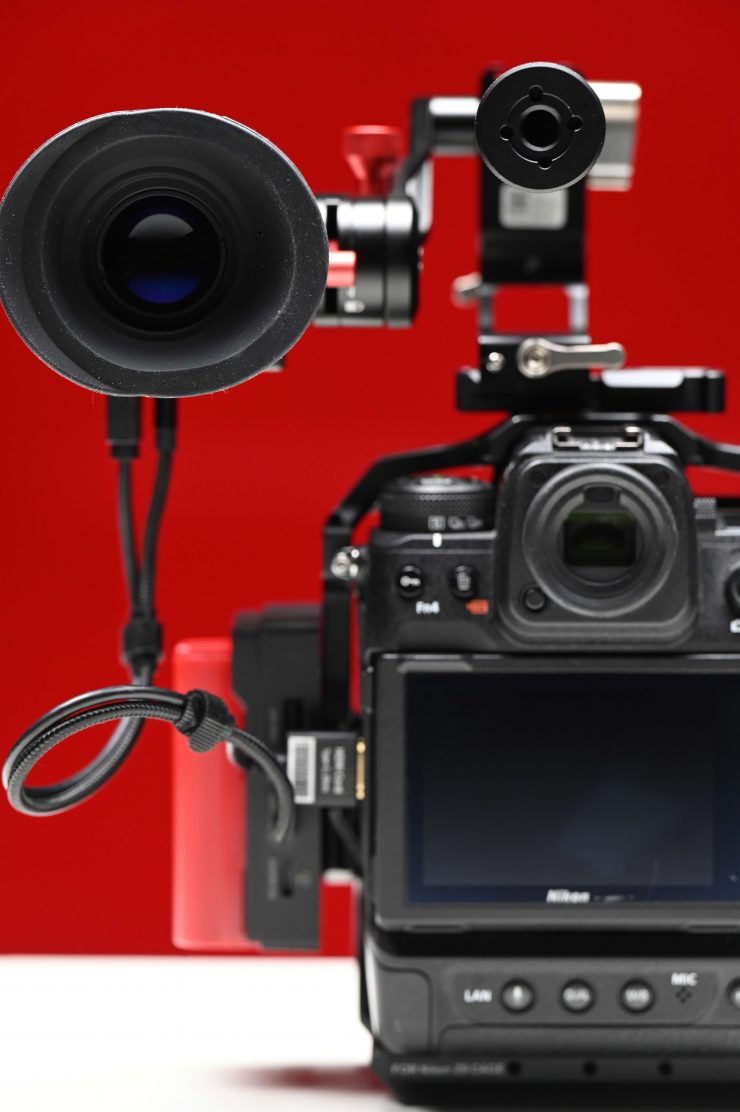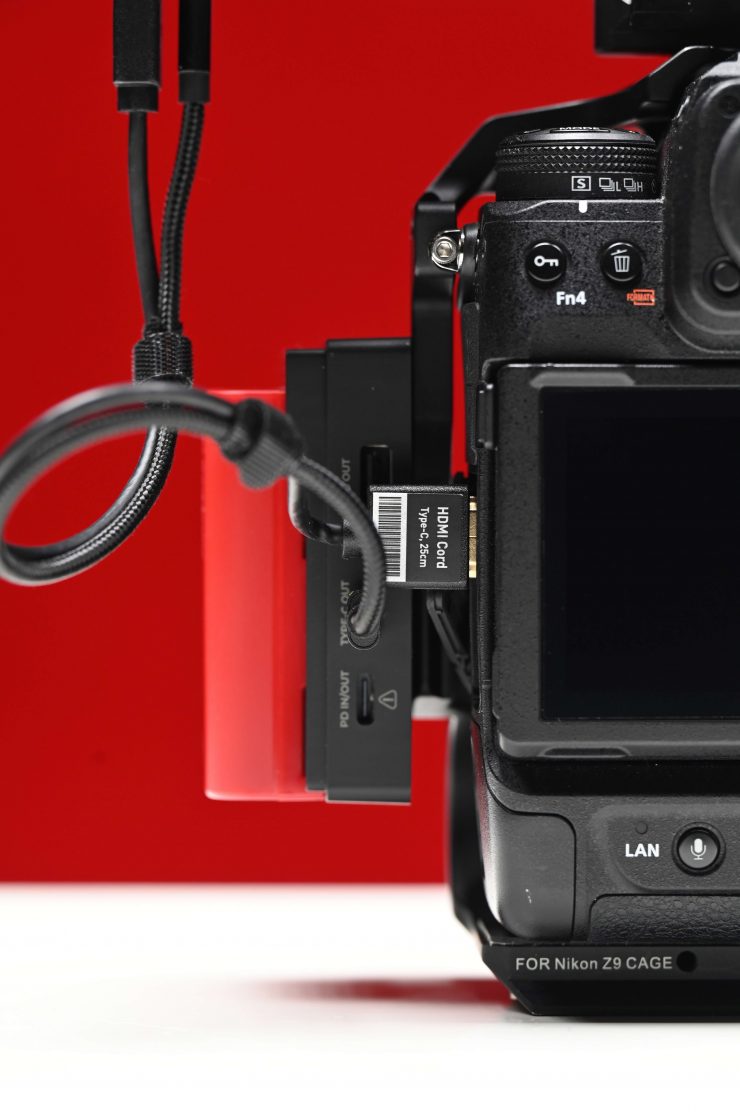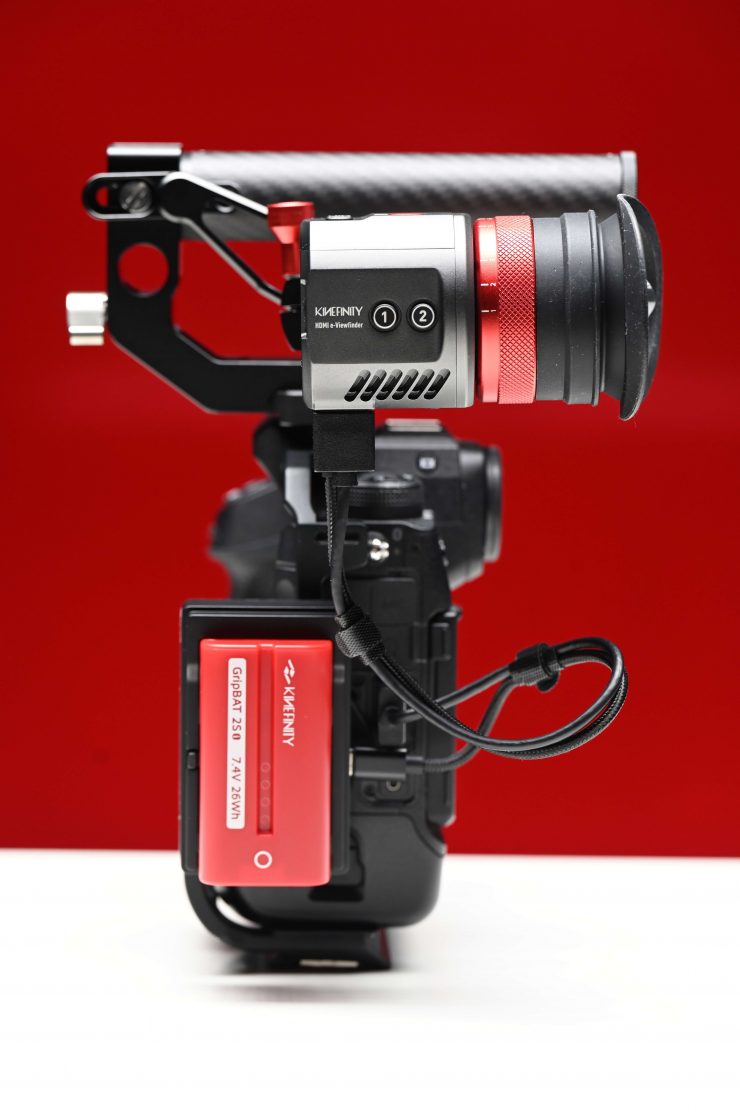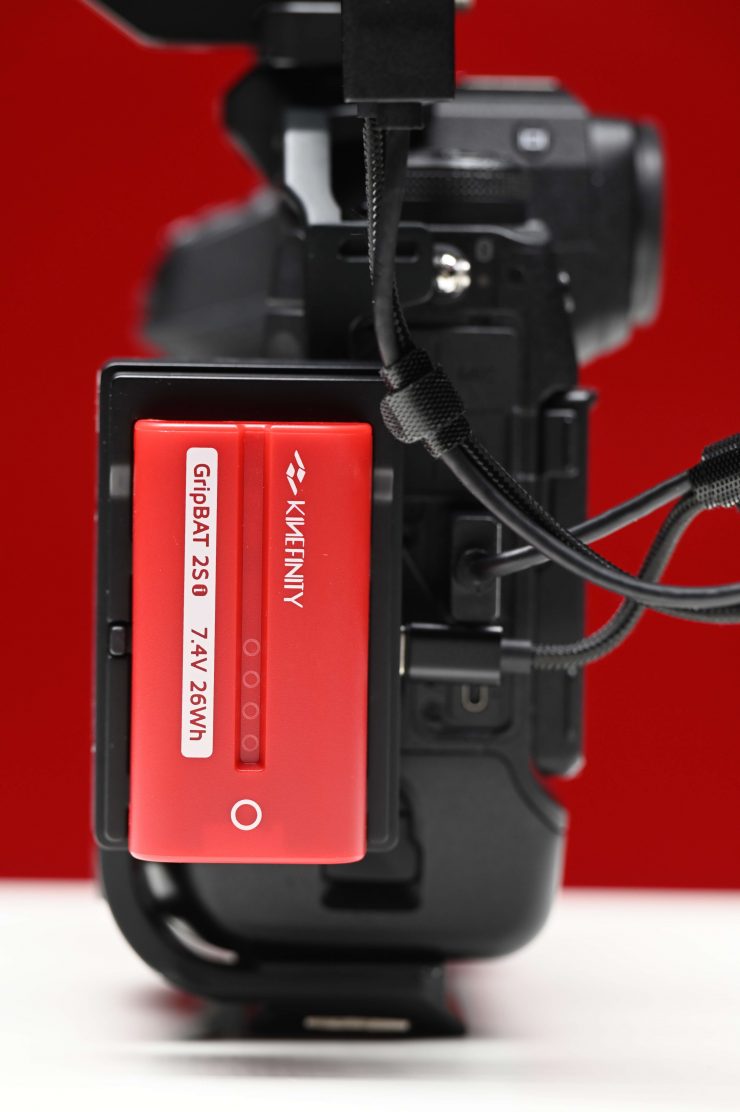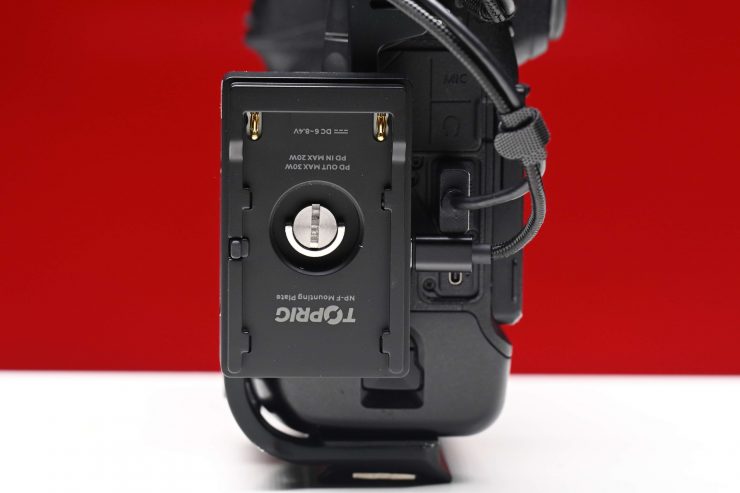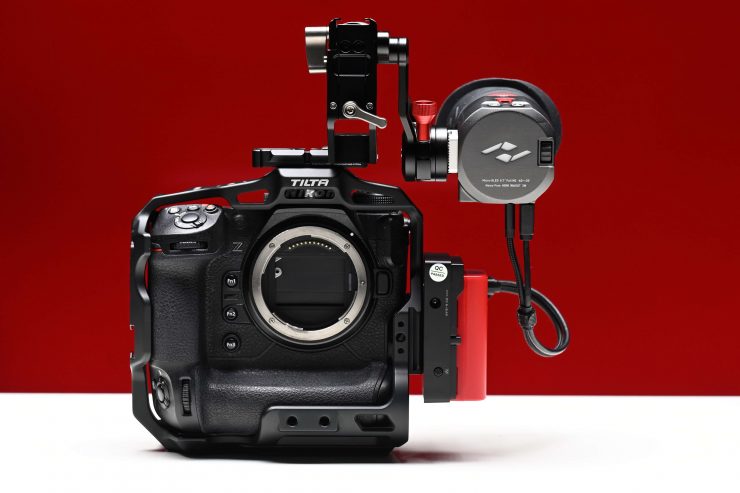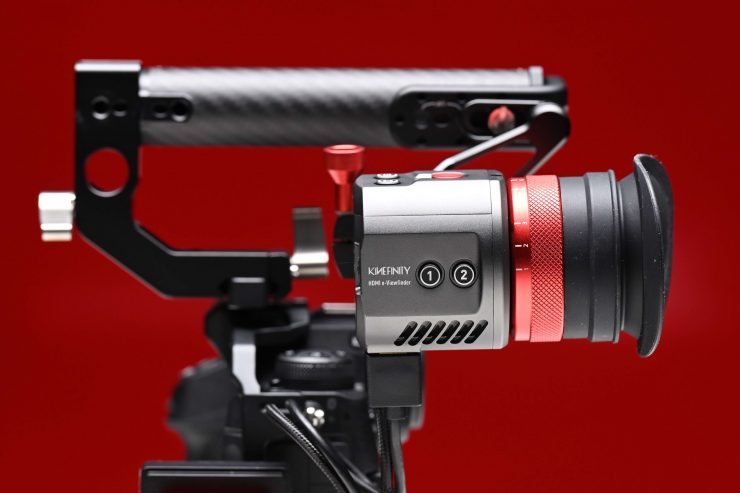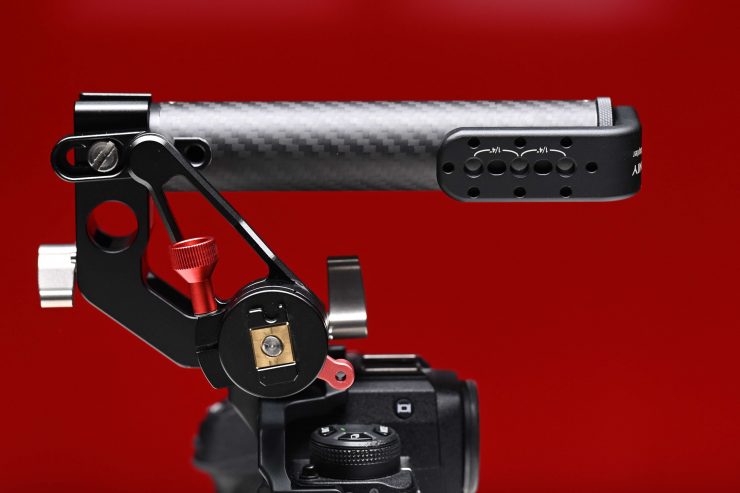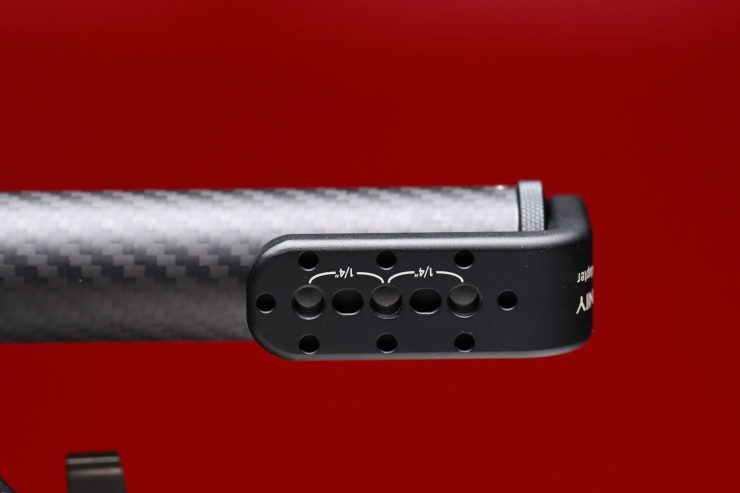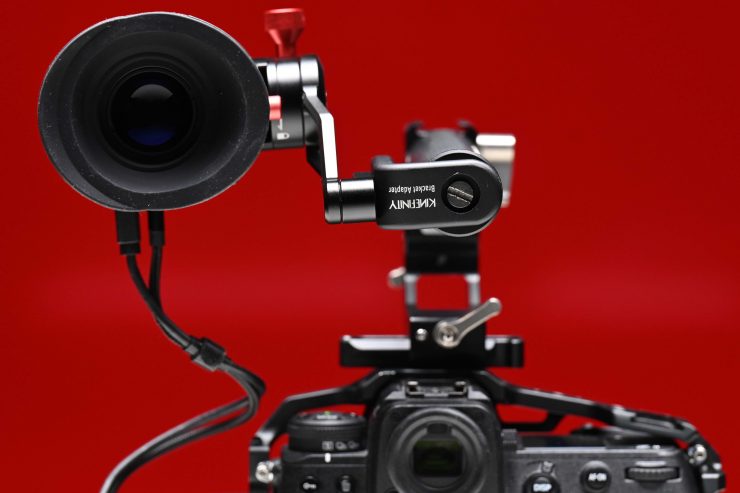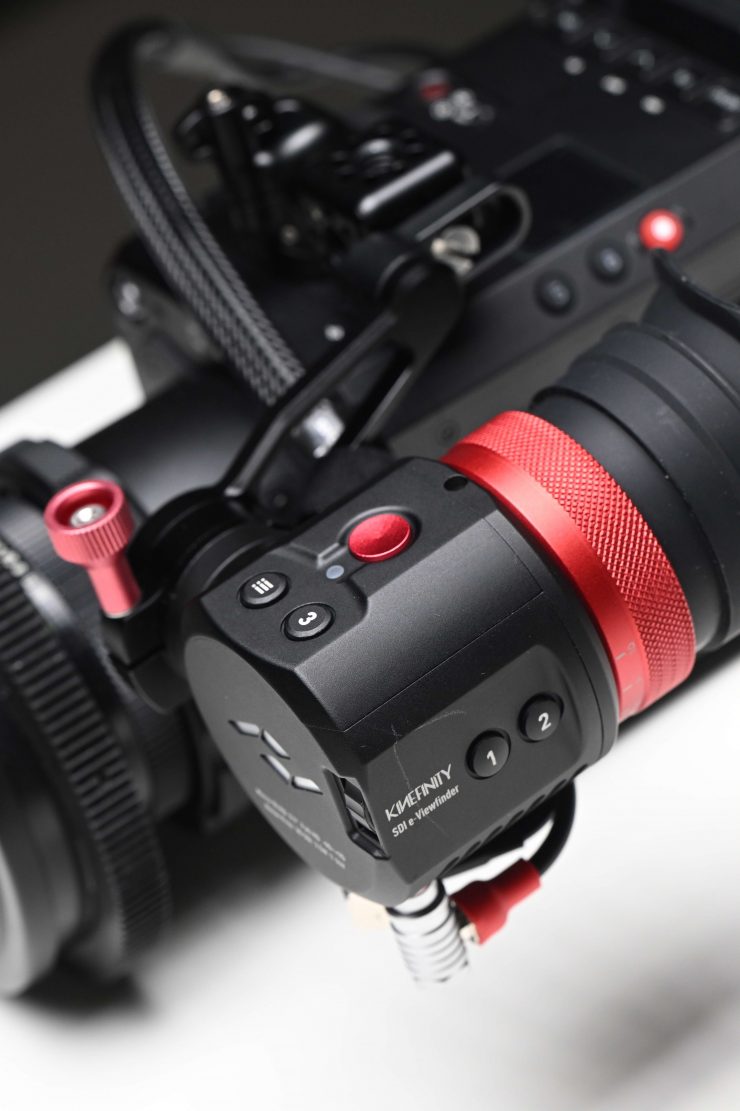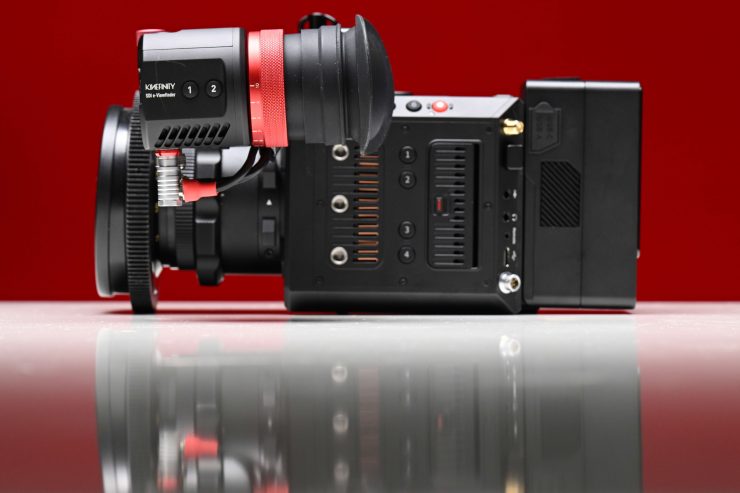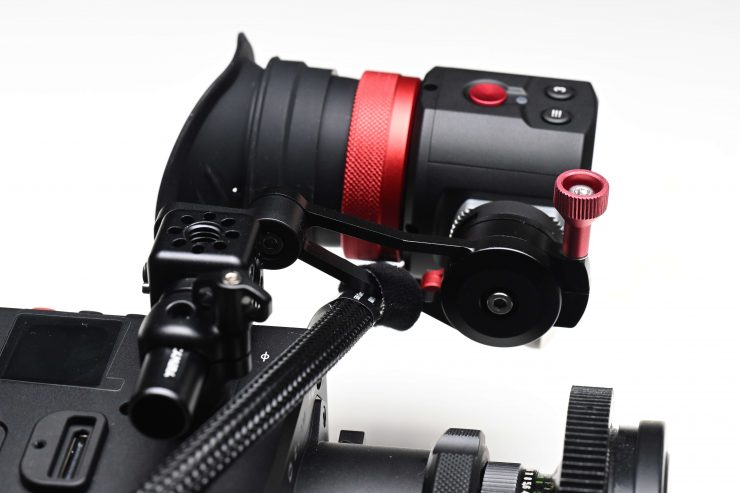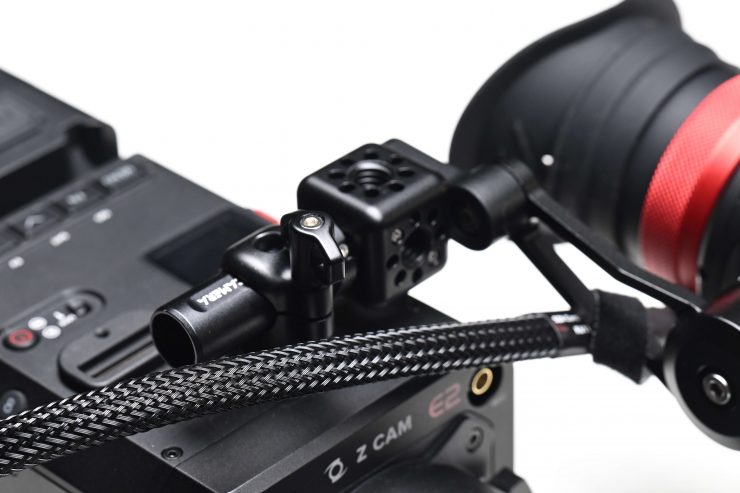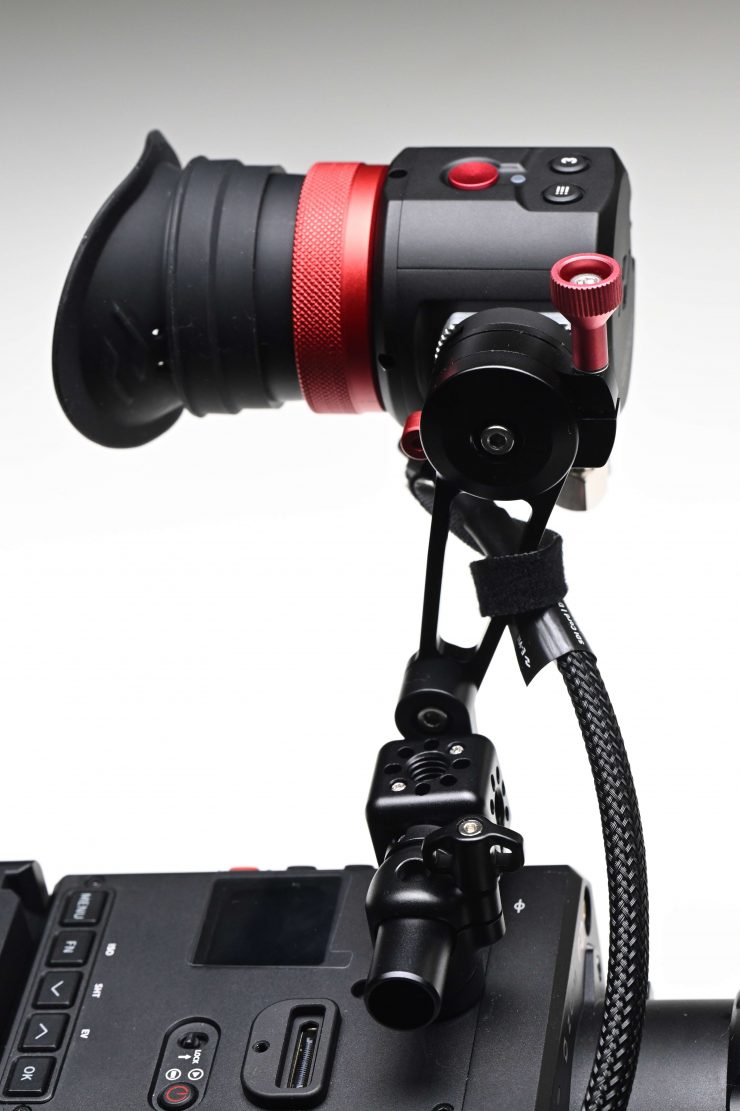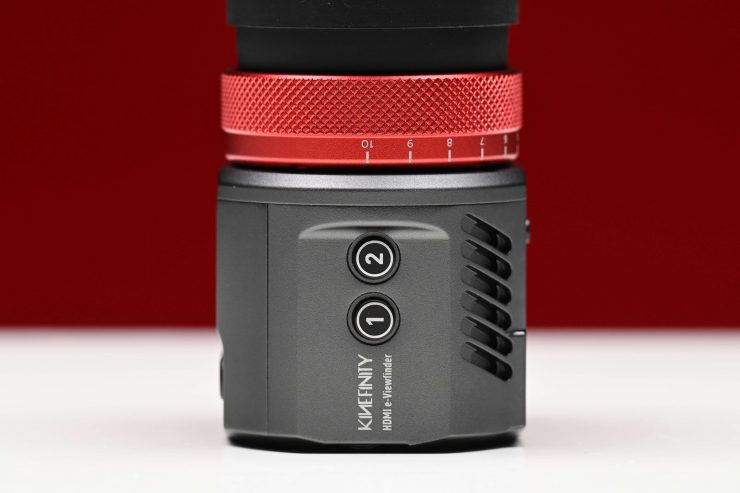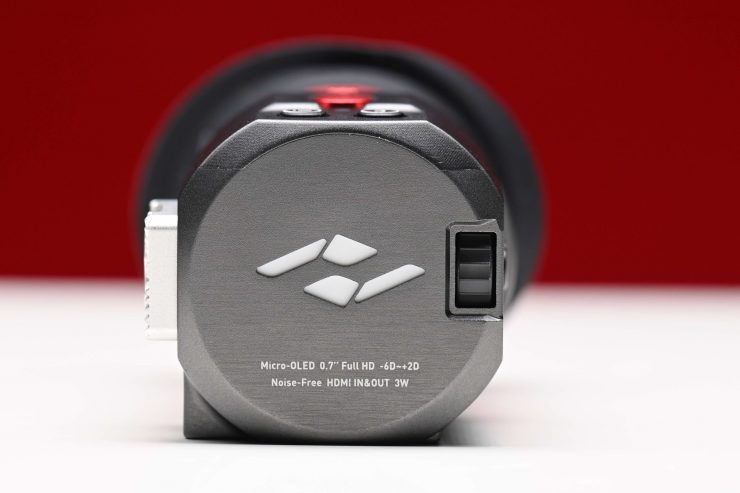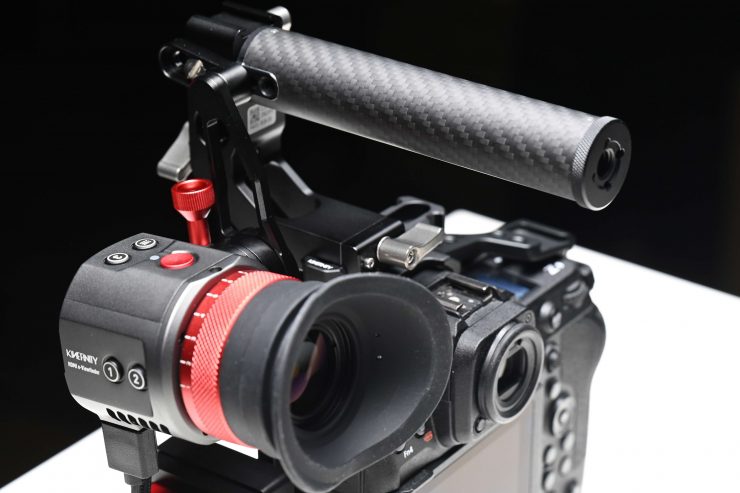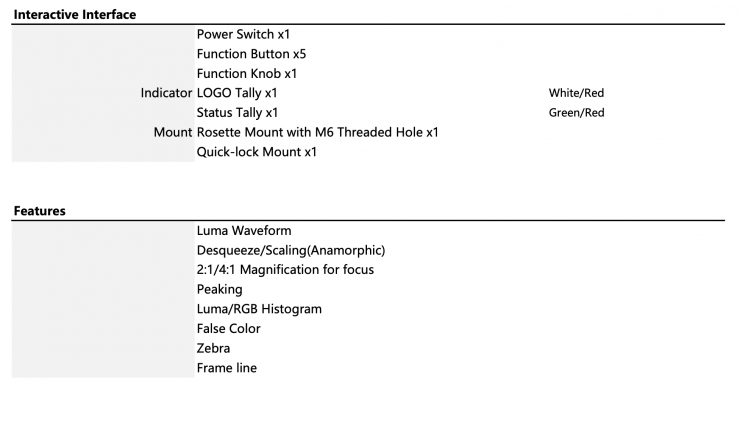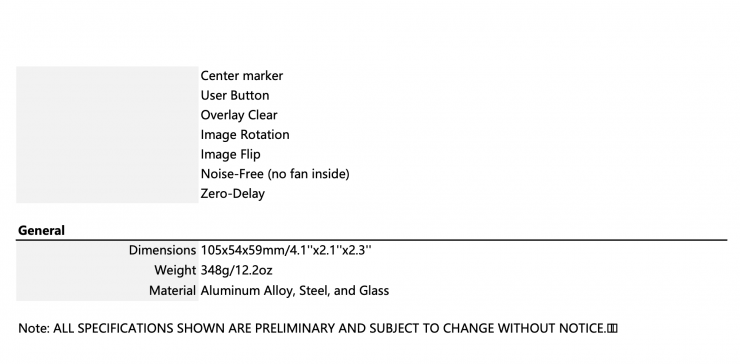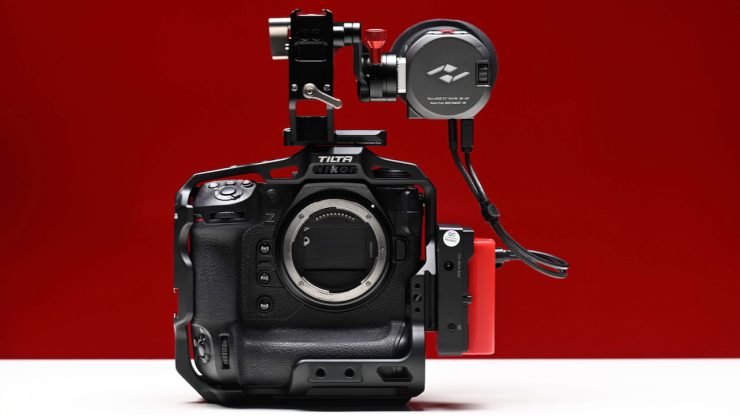
Kinefinity officially released its new EAGLE HDMI e-Viewfinder last month. It was first shown as a prototype at IBC 2024.
The new EVF is a follow-up to the Eagle SDI e-Viewfinder that was first shown at NAB 2024. I previously reviewed that EVF on the site and you can see that review here.
Above you can see my interview with Kinefinity about the EAGLE HDMI e-Viewfinder at IBC 2024. Please note that changes have been made to the design and feature set since the prototype was shown.
There have been very few decent and affordable (of course this is subjective) third-party EVFs on the market.
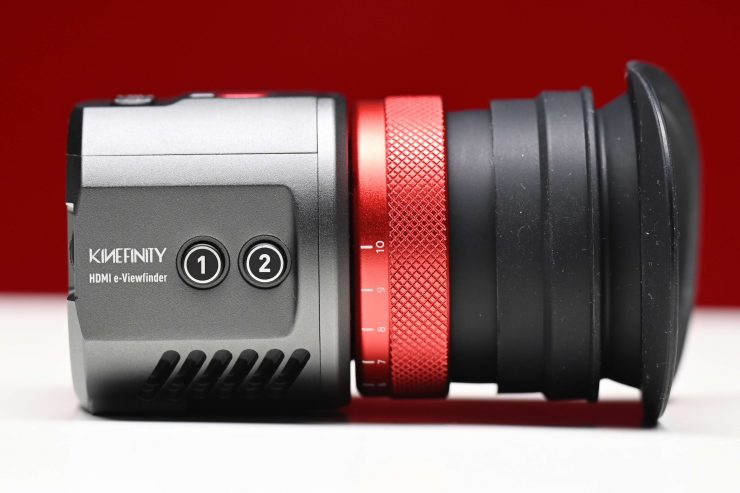
The Eagle HDMI e-Viewfinder is based on the Eagle SDI e-Viewfinder that I previously reviewed on the site. While that is a great EVF it only has an SDI input and wasn’t suitable for use with a lot of smaller digital cinema cameras or mirrorless hybrids.
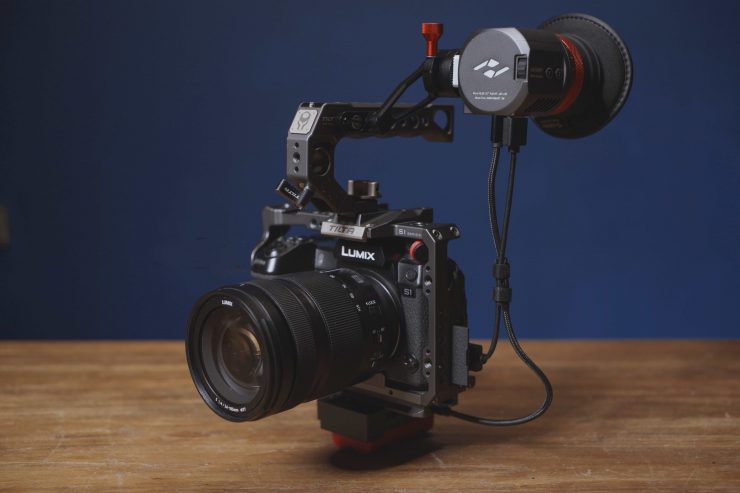
The Eagle HDMI e-Viewfinder looks to be a great option for anyone using smaller-sized cameras that only feature HDMI outputs. It retains many of the features of the SDI version, equipped with a full HD 0.7″ Micro-OLED display and excellent optical design. The viewfinder includes advanced 10-bit color processing to ensure accurate, sharp, and clear images. The EAGLE uses an innovative FPGA-based hybrid processing architecture for quick startup, rapid response, extremely low power consumption, and no additional image delay. Additionally, its fanless design allows the EAGLE HDMI to operate silently, enabling filmmakers to work in quiet environments without distractions.
On the 20th of January, Kinefinity released Firmware v2.1 Update for the Eagle HDMI and SDI e-Viewfinders.
Feature Updates
EAGLE HDMI:
Added display support for timecode, audio VU meters, and recording status for cameras, like Sony and Canon.
EAGLE SDI/EAGLE HDMI:
Expanded support for upgraded USB drives.
(3) EAGLE SDI/EAGLE HDMI:
Optimized the upgrade process.
Bug Fixes
Display Off:
Improved display off feature response speed.
Button Response:
Enhanced button response speed after powering on.
Stability:
Improved overall stability.
There have been options in the past from companies such as PortKeys, and Zacuto, but not many others. There are of course a few proprietary EVFs made by companies such as ARRI, Sony, RED, Kinefinity, and Canon, but those options are generally pretty expensive.
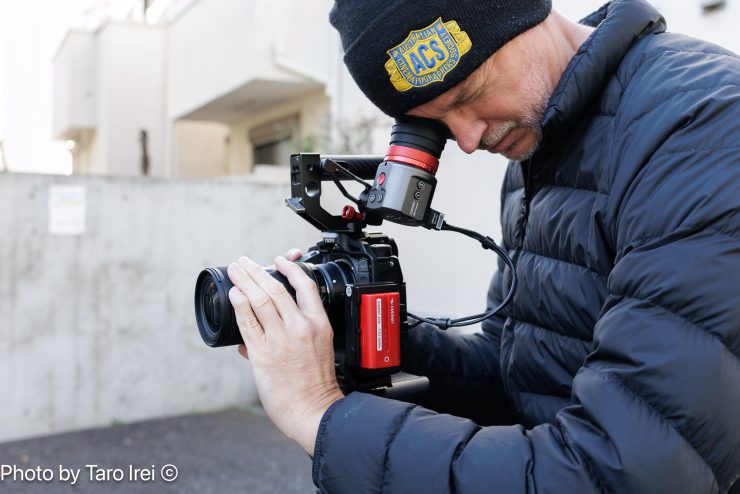
I think we haven’t seen many options come to market because a lot of younger shooters don’t use EVFs (scratches head).
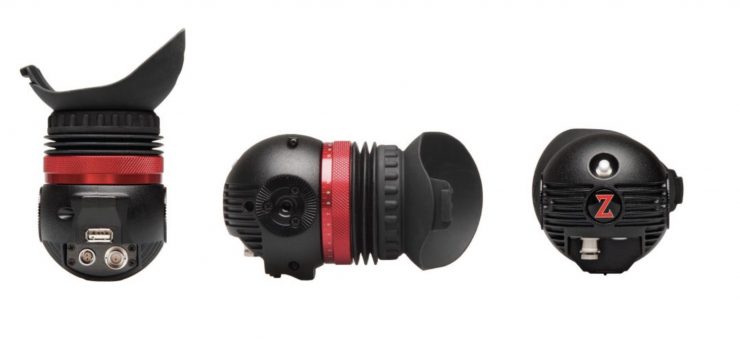
Zacuto’s Gratical and Gratical Eye EVFs were arguably the most popular options for many years. The original Gratical was very large and it wasn’t until 2018 that the smaller and more compact Gratical Eye was announced. The Gratical Eye did away with the battery plate and this allowed Zacuto to make it considerably smaller than its predecessor.
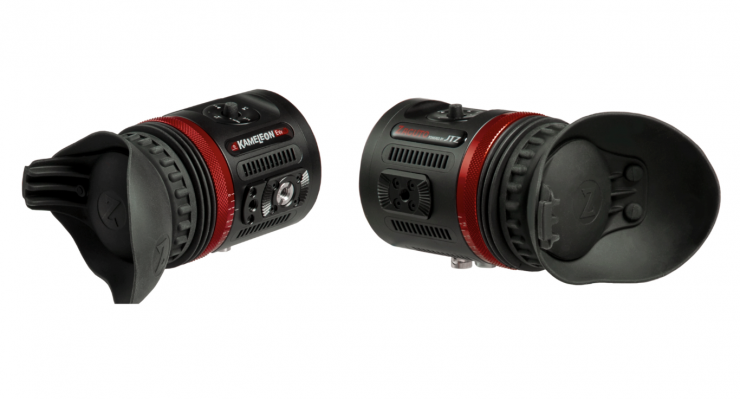
In 2019, Zacuto followed up with the Kameleon Micro-OLED EVF.
A few years ago I told Kinefinity that they should make a universal EVF based on their KineEVF OLED Viewfinder, and they listened.

The new universal viewfinders are somewhat based on their existing KineEVF OLED Viewfinder, which uses a single proprietary cable to send both power and the image from the camera to the EVF.
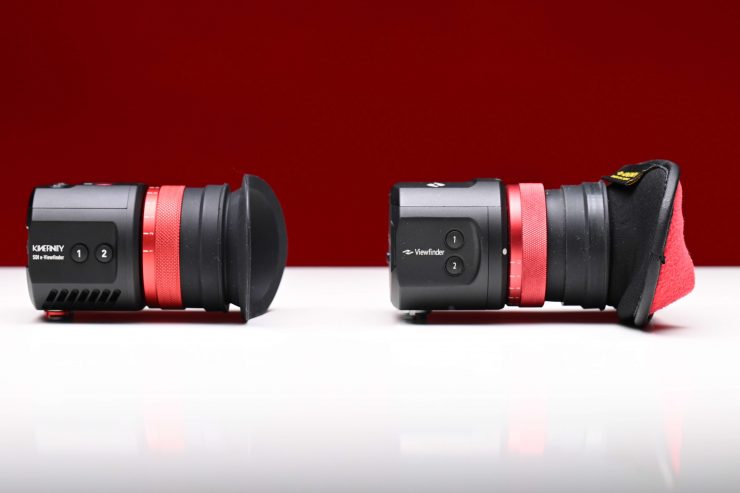
The new EAGLE e-Viewfinders look almost identical, but there are a few small differences as you can see. The universal versions are slightly shorter, and they feature a different mounting plate, and have fewer buttons.
I have used the KineEVF OLED Viewfinder quite a lot and it is an excellent EVF, as it is very compact and small.
1920 x 1080 Micro OLED panel
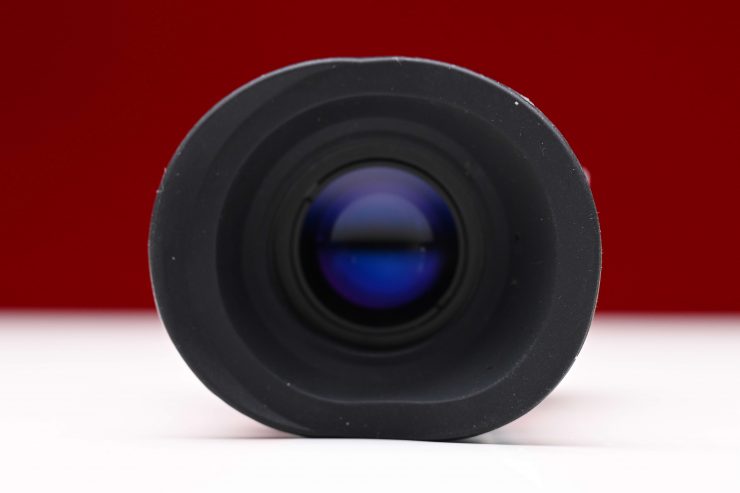
The EVF utilizes a 0.7″ / 1.3cm 1920 x 1080 Micro OLED panel with a contrast of 10,000:1.
The panel supports 8-bit depth and 16 million colors. However, internal processing is conducted at 10-bit depth.
Each EAGLE HDMI e-Viewfinder is claimed to be precisely color-calibrated in production. Under normal circumstances, further calibration is not necessary. If needed, factory calibration is available.
So how does this compare to some of the competition?
| SIZE | RESOLUTION | PPI | |
| Kinefinity Eagle HDMI e-Viewfinder | 0.7″ / 1.3cm | 1920 x 1080 | 3147 |
| Kinefinity Eagle SDI e-Viewfinder | 0.7″ / 1.3cm | 1920 x 1080 | 3147 |
| Zacuto Kameleon EVF Pro | 0.71″ / 1.8cm | 1920 x 1080 | 3103 |
| Z CAM 2.89″ EVF101 Electronic Viewfinder | 2.89″ / 7.3 cm | 1440 x 1440 | 705 |
| PORTKEYS LEYE 3G-SDI & HDMI 2.4″ LCD Electronic Viewfinder | 2.4″ / 6.1 cm | 1440 x 900 | 728 |
| Blackmagic Design URSA Cine EVF | Not Listed | 1920 x 1080 | NA |
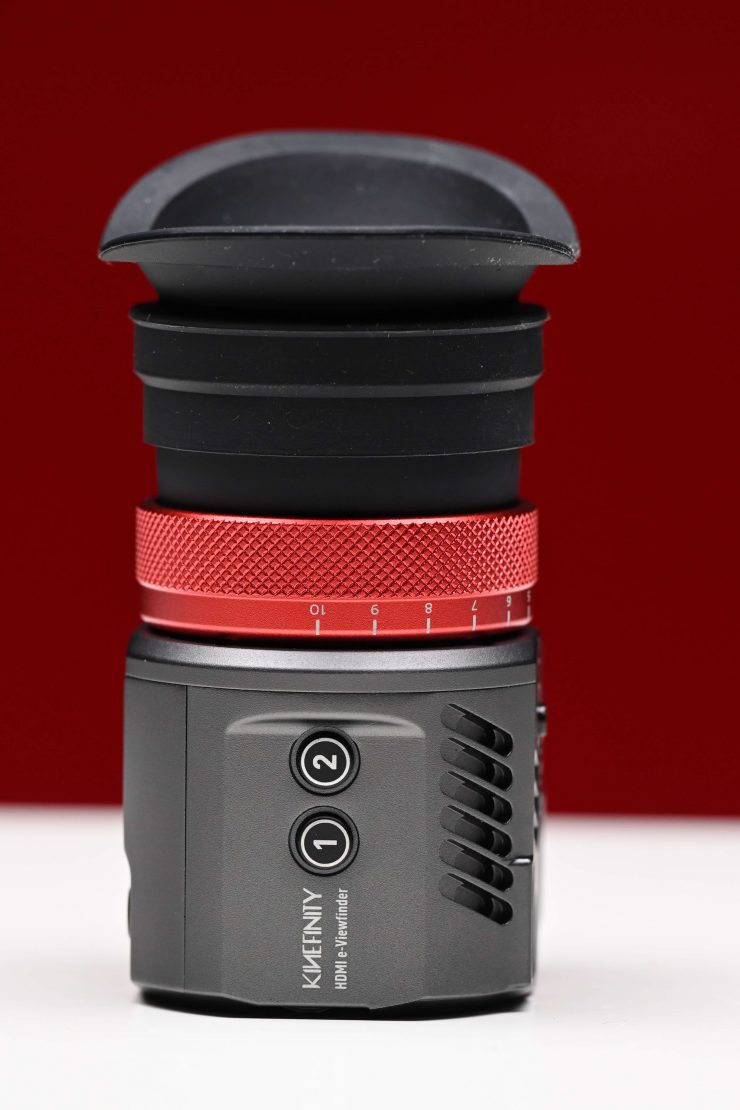
According to Kinefinity, the premium optical eyepiece of the EVF is distinguished by its high resolution, ultra-low chromatic aberration, and broad field of view. The image quality is very nice. When I compared it side by side with the EVF on my ARRI Amira the colors were pretty close, however, I did find that the Eagle e-Viewfinder was more saturated and a little more contrasty.
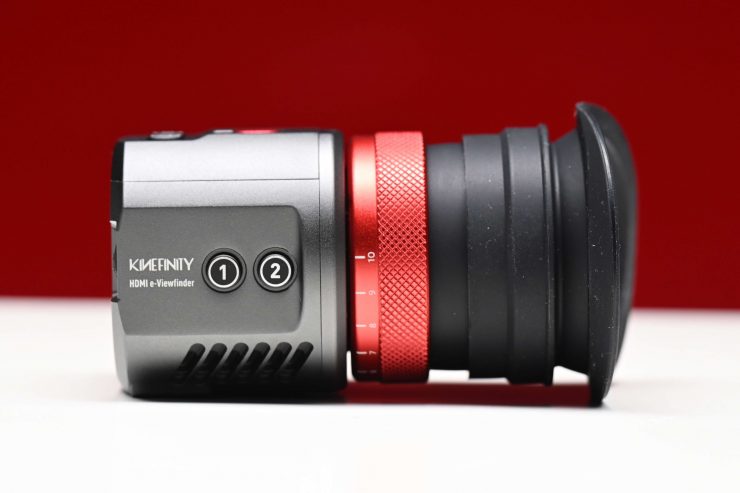
It includes a built-in diopter that can be adjusted from -6D to +2D. This is said to alleviate concerns related to myopia, ensuring a comfortable viewing experience for all users. Now, I personally found that the diopter adjustment wasn’t large enough for my eyes, but my eyes are not great! I think for the majority of people the adjustment range should be enough.
No Proximity Sensor
The EAGLE HDMI e-Viewfinder does not have a built-in proximity sensor. However, it features an automatic screen-off function to protect the OLED screen. It is recommended to manually turn off the viewfinder when not in use. It also doesn’t come with any type of cover over the eyepiece. You need to be careful with some EVFs as you can get serious burn-in if you have the eyepiece facing the direct sun.
Power
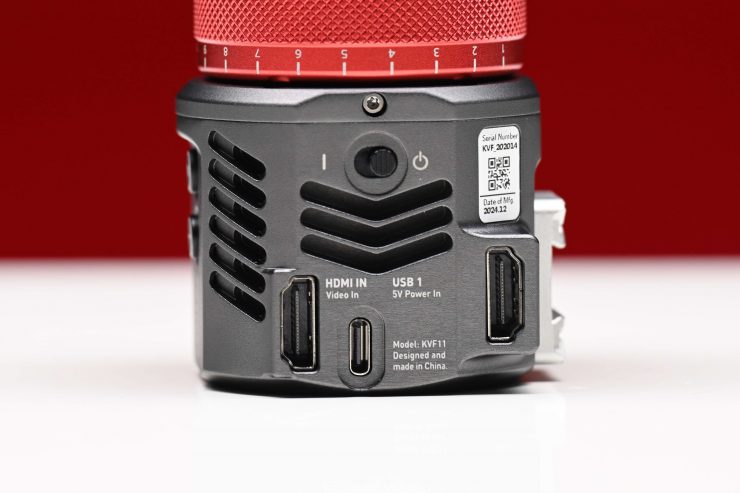

Eagle HDMI e-Viewfinder 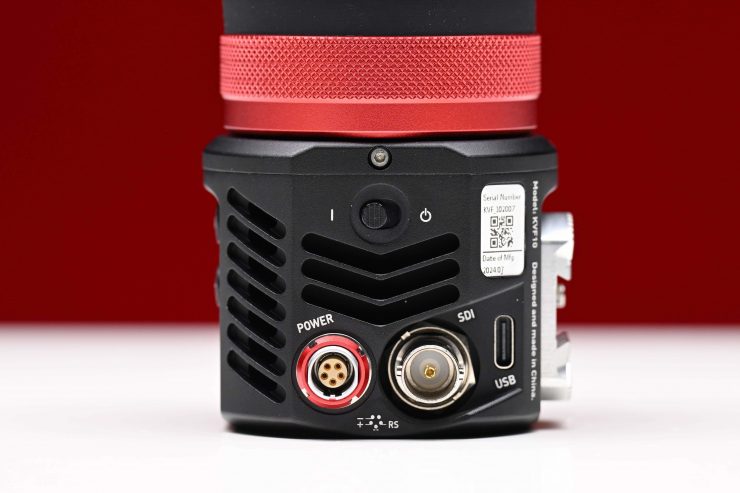
Eagle SDI e-Viewfinder
The Eagle HDMI e-Viewfinder is powered via a USB-C input The power draw of the EVF is just 2.5W. This is different from the Eagle SDI e-Viewfinder which has a 5-Pin 7-24V input.
So how does this compare to the competition?
| POWER INPUT | POWER DRAW | |
| Kinefinity Eagle HDMI e-Viewfinder | USB-C | 3W |
| Kinefinity Eagle SDI e-Viewfinder | 5-Pin 7-24V | 2.5W |
| Zacuto Kameleon EVF Pro | LEMO 4-Pin 7-20V | 5W |
| Z CAM 2.89″ EVF101 Electronic Viewfinder | LEMO 2-Pin | 5.5W |
| PORTKEYS LEYE 3G-SDI & HDMI 2.4″ LCD Electronic Viewfinder | External LP-E6 Battery | 5W |
| Blackmagic Design URSA Cine EVF | USB-C | NA |
In the EAGLE HDMI e-Viewfinder CORE KIT Kinefinty includes an Accsoon Toprig Battery Plate x1.
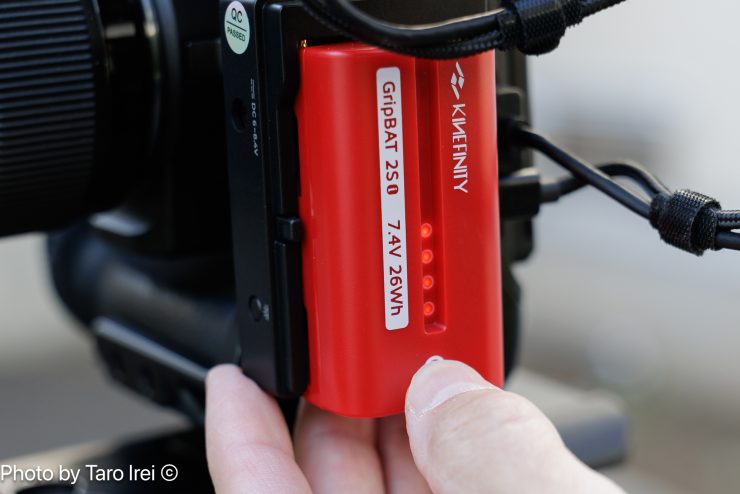
In the EAGLE HDMI e-Viewfinder PRO KIT Kinefinty includes a GripBAT 2Si x2 + PD Hybrid Dual Charger Pack x1 that you can use as well as an Accsoon Toprig Battery Plate x1.
Inputs & Outputs
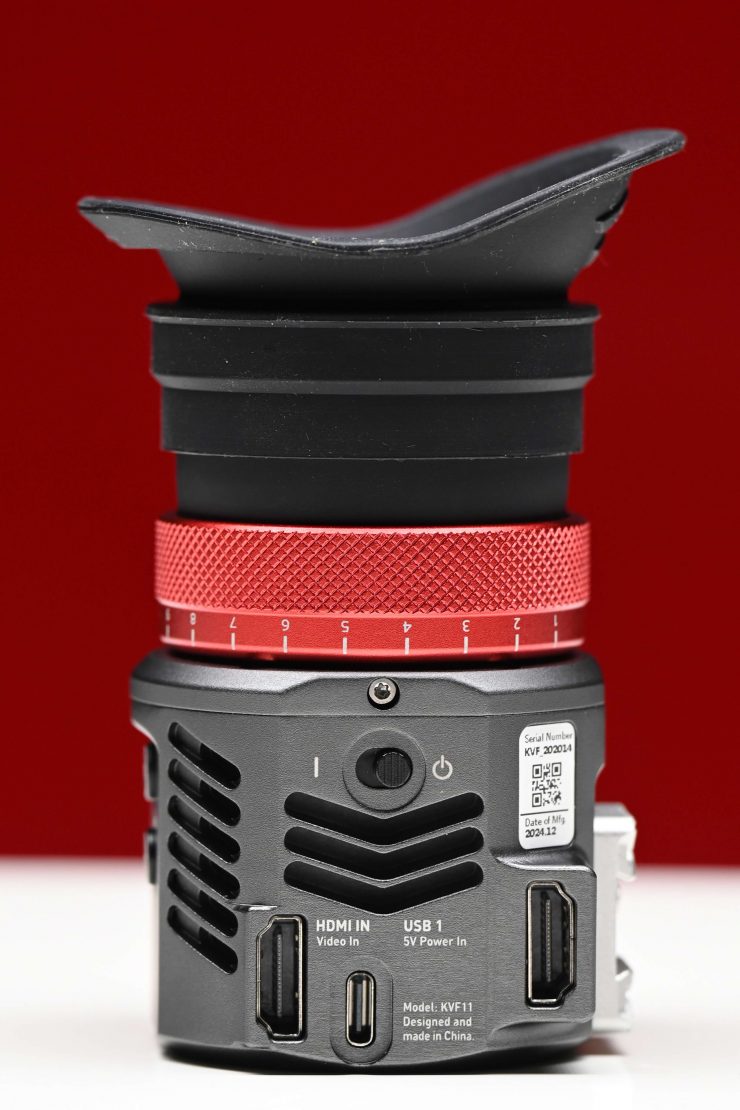
The Kinefinity Eagle SDI e-Viewfinder has the following inputs and outputs:
- HDMI input
- HDMI loop-through output
- USB-C input
HDMI Signal Formats 1980×1080
- @23.98p/24p/25p/29.97p/30p/47.95p/50p/59.94p/60p
- @23.98psf/24psf/25psf/29.97psf/50i/59.94i/60i
USB-C
Some shooters may be wondering about whether or not you could use the USB-C input so that both power and video could be sent over a single cable. Well, currently there are not many cameras that could actually utilize this, especially those that can send both power and video. The new Blackmagic Design URSA Cine EVF can receive both video and power from the URSA Cine and the Canon C400 LCD actually connects to the camera using a USB-C cable.
In theory, just like the Blackmagic Design URSA Cine EVF, the Kinefinity Eagle HDMI e-Viewfinder could potentially work with the Canon C400, however, Kinefinity told me that their USB-C input is only for power.
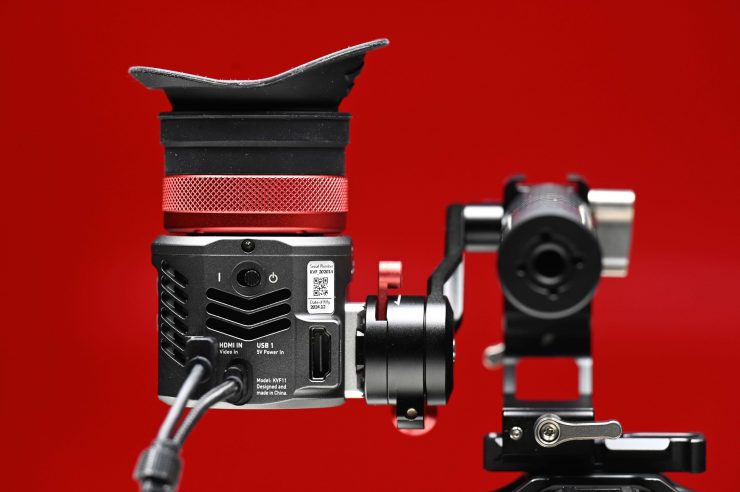
Separate power and video inputs currently make a lot more sense as they allow the EVF to be used with far more cameras.
Build Quality
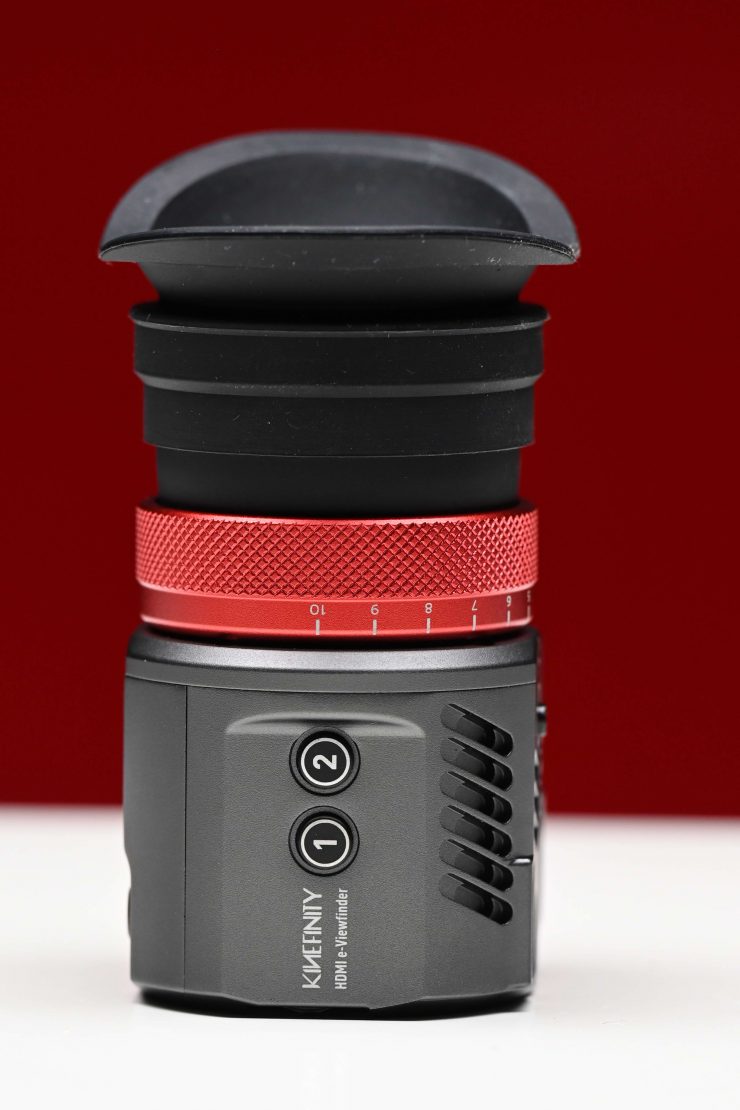
The build quality of the Kinefinity Eagle HDMI e-Viewfinder is excellent. The casing is made out of aluminum and the buttons and dials are tactile and solid. It is very well made and constructed.
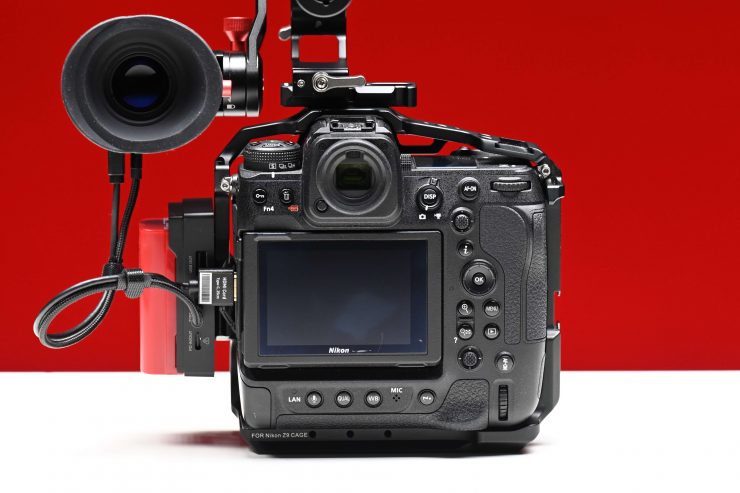
The included HDMI and USB-C power cable have been coiled together which makes cable management a lot easier.
Size & Weight
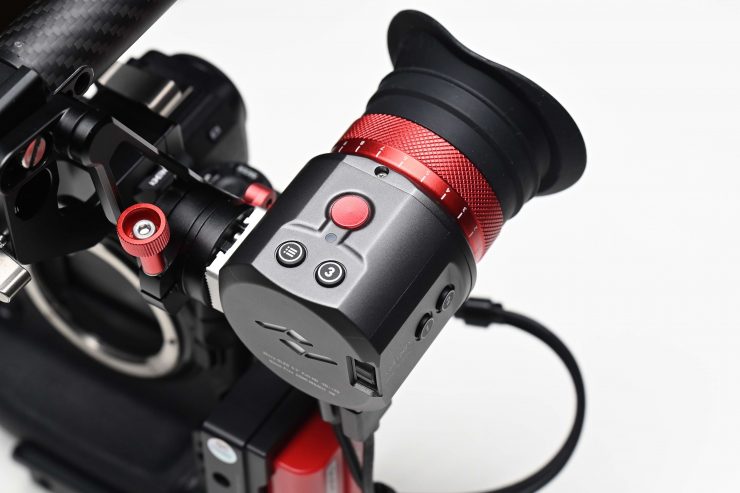
The Eagle HDMI e-Viewfinder weighs 348g / 12.2oz and it has physical dimensions of 105 x 54 x 59mm / 4.1” x 2.1” x 2.3”.
Despite being made out of aluminum. Kinefinity states that its EVF is 40% lighter than competing products. I am not sure where they got that figure from, given the closest competitor is less than 100g heavier.
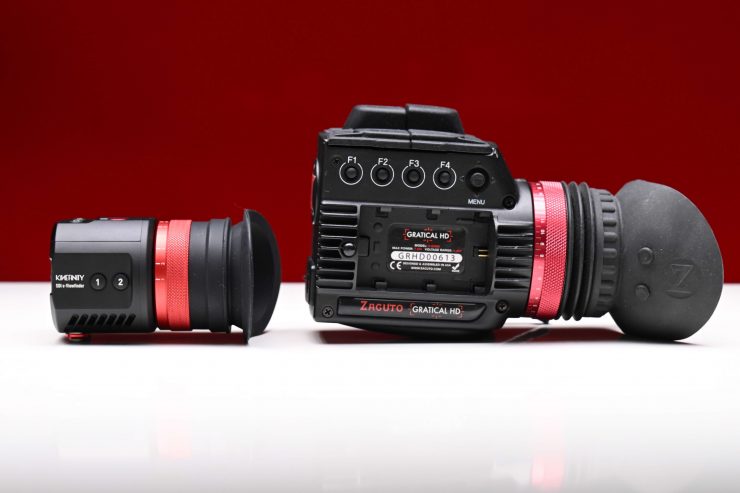
Above you can see how the Kinefinity Eagle SDI e-Viewfinder ( which is the same size as the Eagle HDMI e-Viewfinder compares in size to the original Zacuto Gratical. When it was released the Zacuto Gratical was by far the best universal option on the market by a country mile.
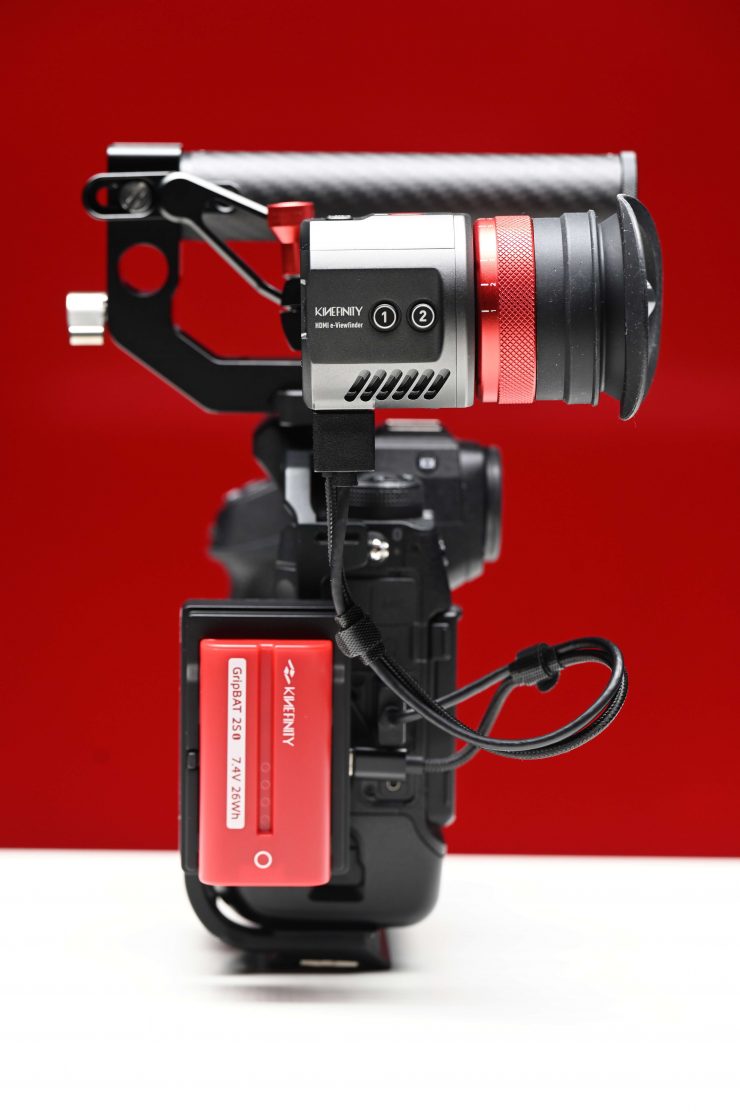
It is nice and compact for a universal EVF which makes it suitable to use on a variety of cameras. As it has an HDMI input you can also use it with mirrorless hybrids.
So how does the weight compare to some of the competition?
| WEIGHT | |
| Kinefinity Eagle HDMI e-Viewfinder | 348g / 12.2 oz |
| Kinefinity Eagle SDI e-Viewfinder | 348g / 12.2 oz |
| Zacuto Kameleon EVF Pro | 430g / 15 oz |
| Z CAM 2.89″ EVF101 Electronic Viewfinder | 612.6g / 21.61 oz |
| PORTKEYS LEYE 3G-SDI & HDMI 2.4″ LCD Electronic Viewfinder | 265g / 9.35 oz |
| Blackmagic Design URSA Cine EVF | 265g | 9.35 oz |
The Kinefinity Eagle HDMI e-Viewfinder is lighter than the Zacuto Kameleon EVF Pro but heavier than the PORTKEYS LEYE 3G-SDI & HDMI 2.4″ LCD Electronic Viewfinder.
Zero Delay
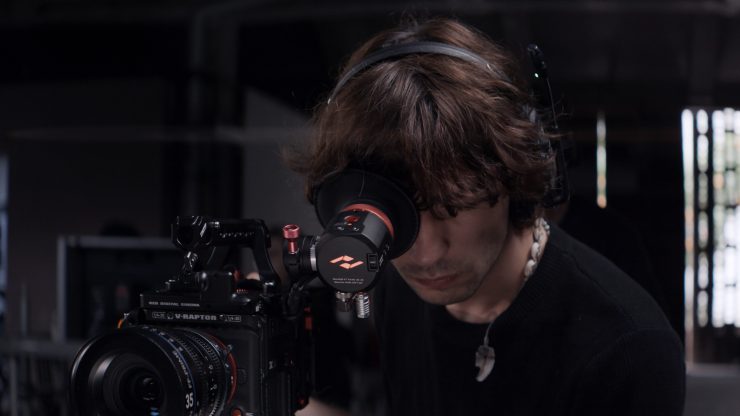
The EVF is claimed to utilize an innovative FPGA-based hybrid processing architecture, that is said to provide rapid boot-up, quick responsiveness, ultra-low power consumption, and virtually no delay in monitoring equipment. With ultra-low power consumption and no fan inside, the EVF operates silently.
Kinefinity claims that the zero-delay feature of EVF ensures real-time framing and seamless focusing, providing results that are similar to using an optical viewfinder, rather than an electronic one.

I was impressed by the lack of delay on the EVF. On a lot of universal EVFs and even some expensive proprietary ones, I have seen some pretty bad lagging and even ghosting of the image.
Mounting
Kinefinity makes some good mounting solutions for the Eagle HDMI e-Viewfinder that allow it to be easily attached to a wide array of cameras. Kinefinity took a lot of the suggestions I made to them about coming up with a variety of different mounting configurations.
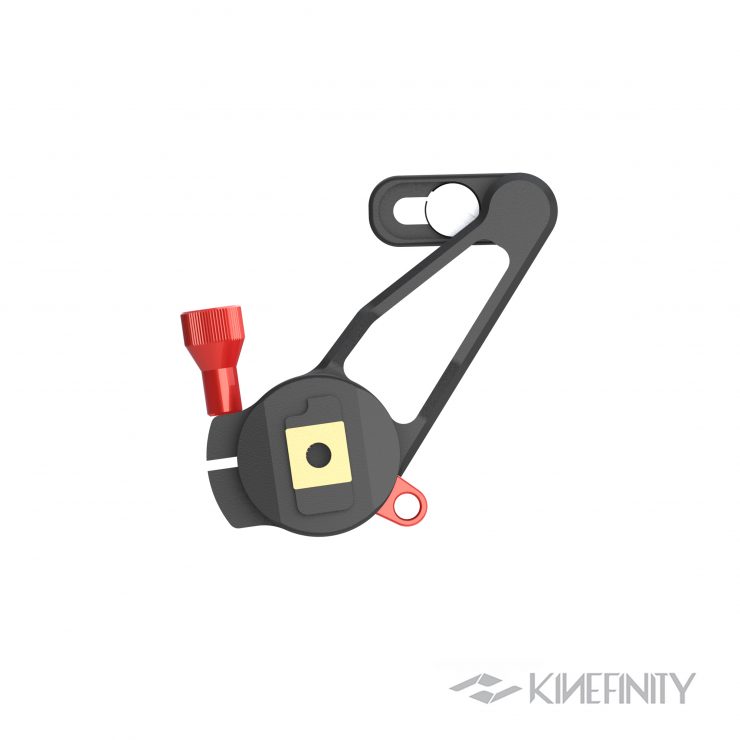
The viewfinder features a replaceable Rosette design, and through Quick-lock Mount, 1/4″-20, and M6 threads, it can be assembled in at least five different configurations, allowing easy integration with professional cameras and providing flexibility for various shooting needs.
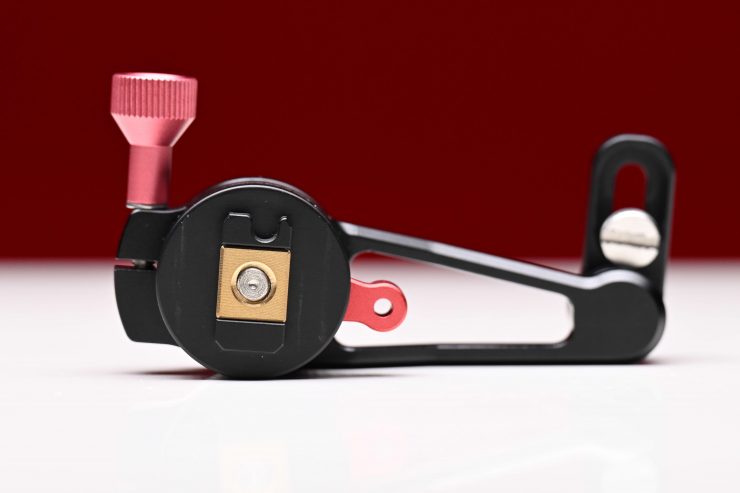
The other is Movcam’s more compact, flexible quickplate bracket that attaches directly to the EVF.
Mounting can be the Achilles heel of most universal EVFs. As universal EVFs need to work with a wide variety of cameras there is no one-stop solution when it comes to mounting. What may work well on one camera, may not work well on another.
The Movcam Flexible quickplate bracket is a nice solution as long as you have a camera with the ability to mount it in the place it needs to go. As it is not particularly big and doesn’t offer a lot of adjustability when it comes to length, you have to think carefully about where to place it on your camera.
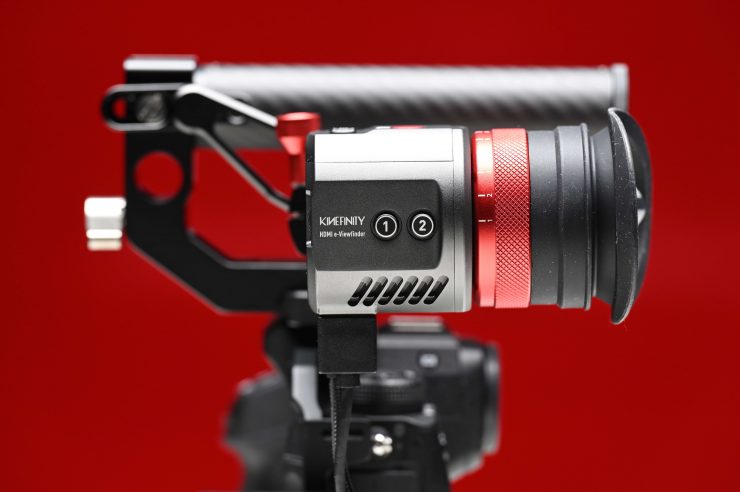
I personally think one of the best solutions is to use the Movcam Flexible quickplate bracket with the optional Movcam Carbon Fiber Top Handgrip as you can attach it directly to any camera cage using a NATO rail. If your camera doesn’t have a top handle, this is a good way to kill two birds with one stone.
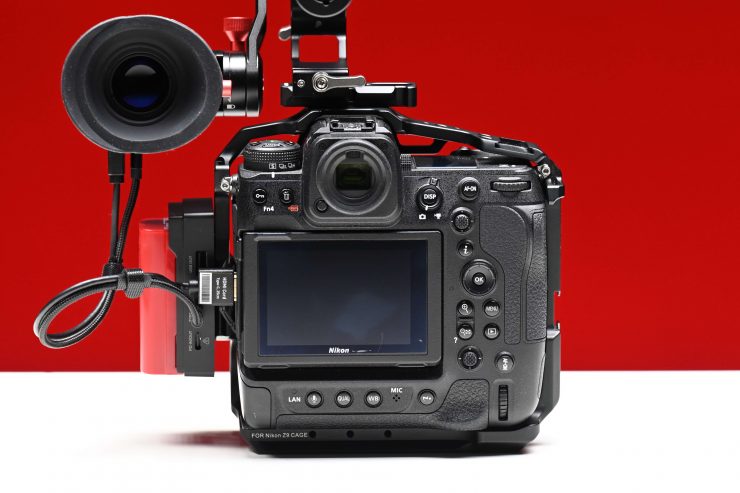
I used this combination with the optional Accsoon Toprig Battery Plate and a Kinefinity GripBAT 2Si to power the EVF on a Nikon Z9. The only slight caveat is that I would need to loosen the Accsoon Toprig Battery Plate to remove the Nikon Z9 battery.
I do, however, find it a little strange that Kinefinity doesn’t include the rod mount adapter in the EAGLE HDMI e-Viewfinder Pro KIT, as it would make the most sense to use with the Movcam Carbon Fiber Top Handgrip.
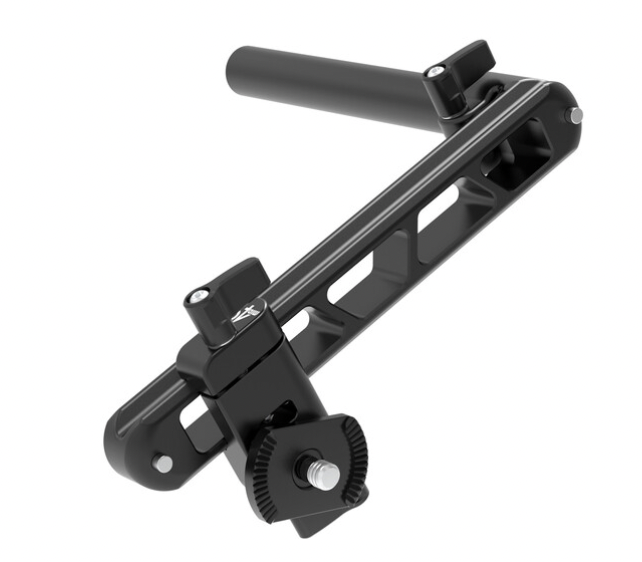
If you wanted to, you could get the MID49 TWIST Mount EVF Kit for Kinefinity EAGLE SDI e-Viewfinder ($249 USD), which will work with the HDMI version as well. You will end up increasing the footprint of your camera and EVF when using this, but it will give you more range and adjustability.
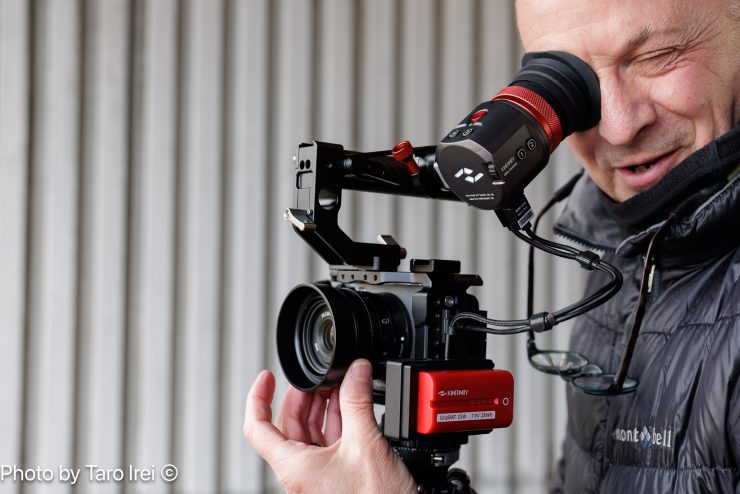
Above you can see the same combination mounted on a Sony FX3.
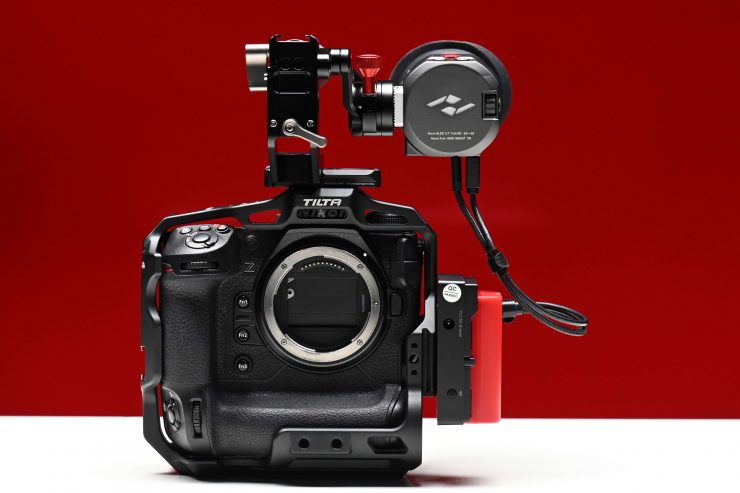
The Movcam Carbon Fiber Top Handgrip also allows you to get a bit of side-to-side adjustment by sliding it along the NATO rail, which is something you can’t do if you just use the E-Viewfinder Mini Mount.
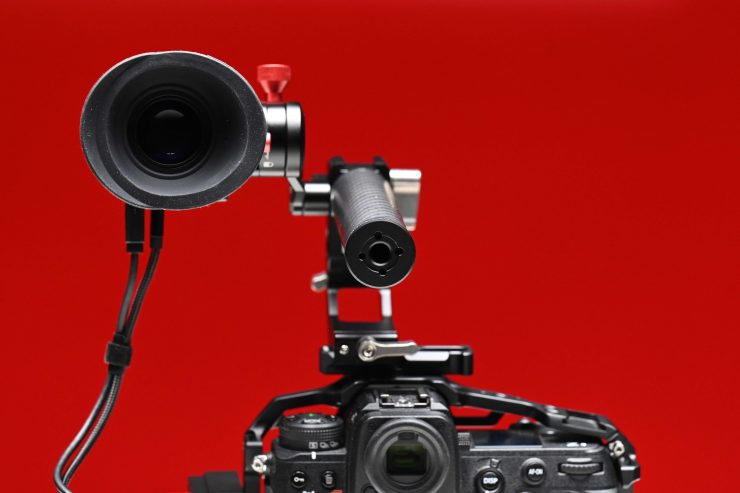
This combination also allows you to place the Eagle HDMI e-Viewfinder up high if need be.
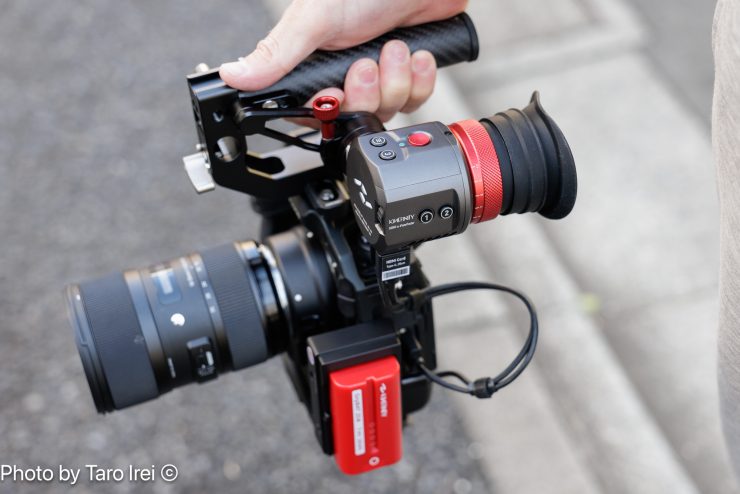
Having a top handle is also super handy and it makes carrying smaller-sized cameras easier.
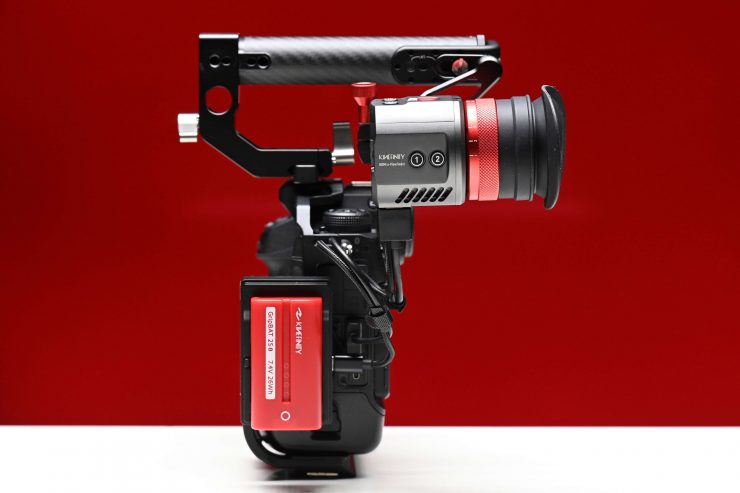
You can also attach the optional Bracket Adapter to the back of the Movcam Carbon Fiber Top Handgrip which can be handy if you need to place the EVF way back on the camera.
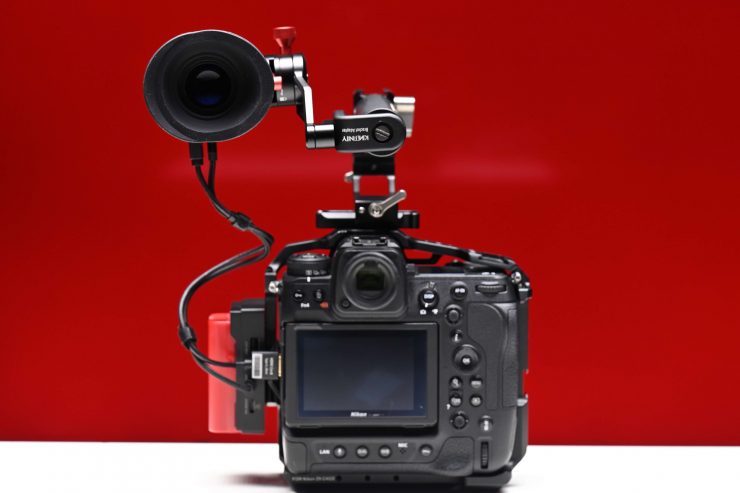
The only issue with this is it doesn’t line up completely level, but you could use it in a pinch.
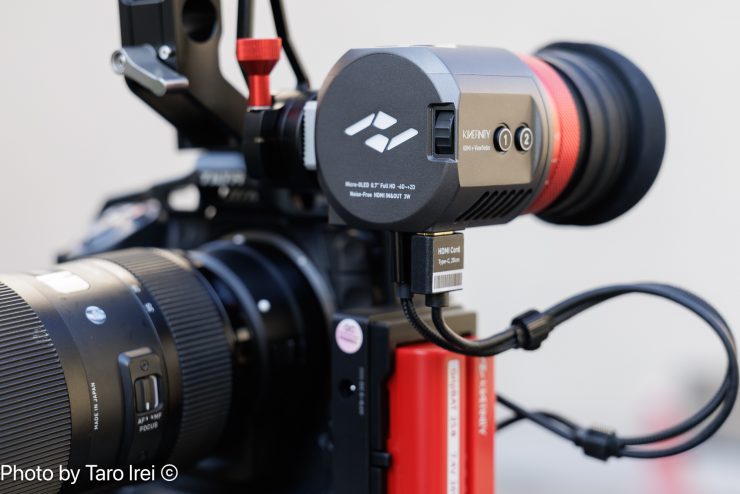
I have found over the years that you sometimes need to be a bit creative to come up with mounting solutions for universal EVFs. I don’t recommend using an EVF on most monitor arms, because this is not only extremely fiddly to adjust, but it is also very hard to get it level and set in the right position.
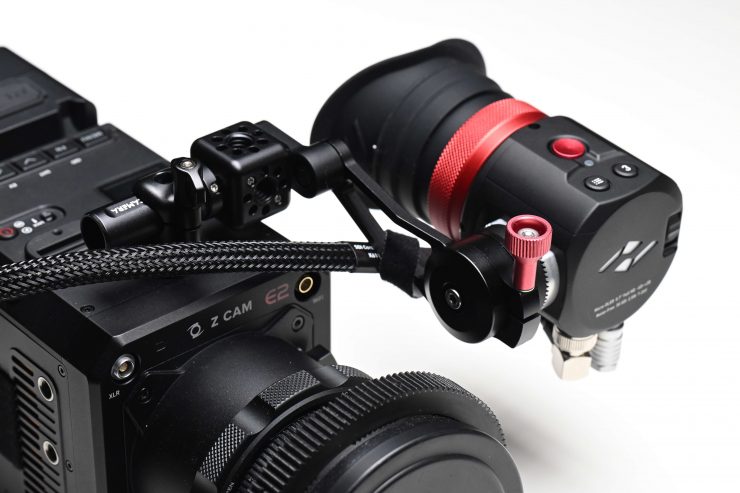
Above you can see some examples of how I used a combination of the Movcam flexible quickplate bracket and three Wooden Camera components to mount the SDI version of the viewfinder (you could do the same thing with the HDMI version):
- Wooden Camera Accessory Cube (1/4″-20 Screw, 1/4″-20 Threads)
- Wooden Camera Universal Single 15mm Rod Clamp with 3/8″-16 Anti-Twist Screw Mount
- Wooden Camera 15mm Bolt-On Rod with 3/8″-16 Mount (1.5″)
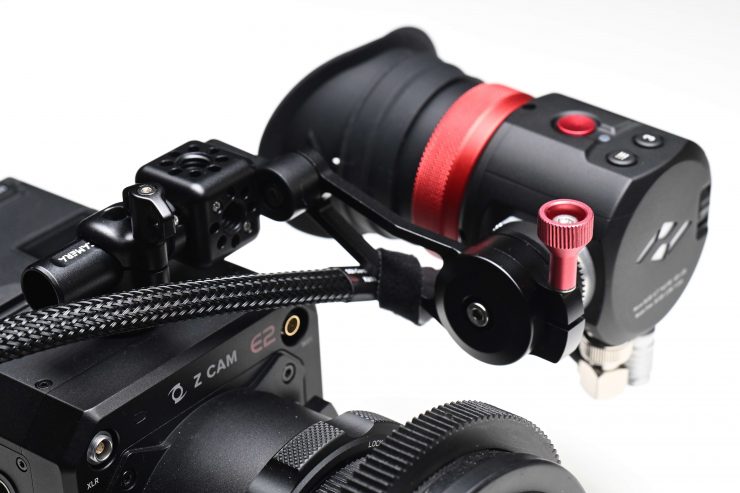
Yes, this was a bit of a convoluted solution, but it did work pretty well on the camera I tried it with. It also gave me both side-to-side and forward and back adjustability.
Buttons & Control
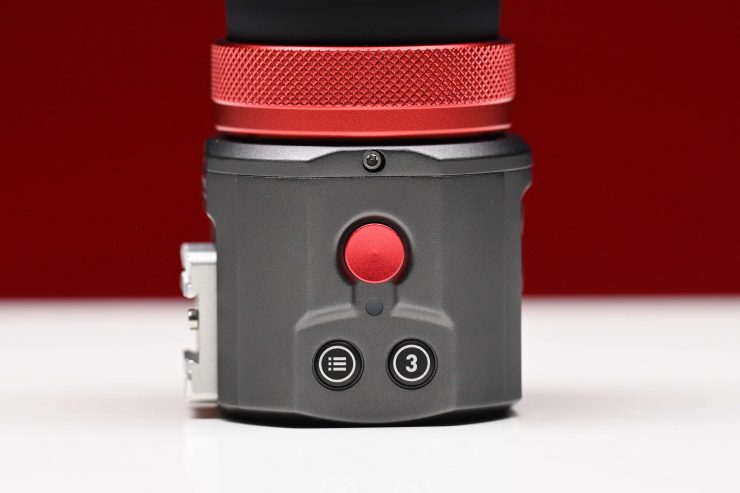
There are 4 function buttons, a Menu button, a toggle button, and a function knob for making changes.
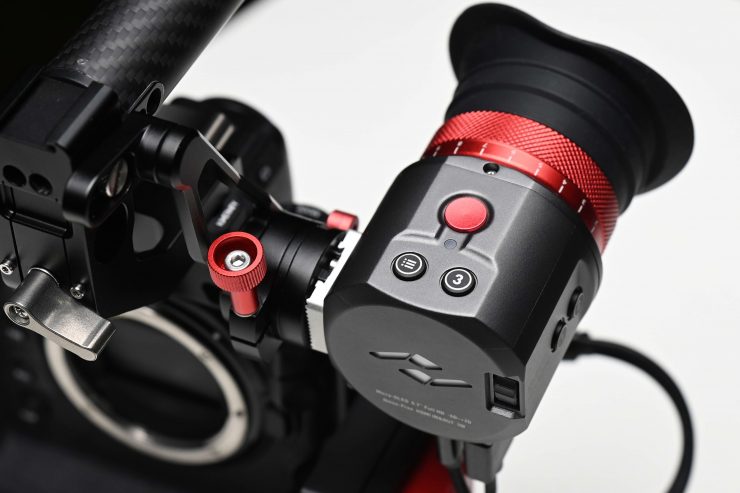
These are easy to use and nicely positioned on the EVF.
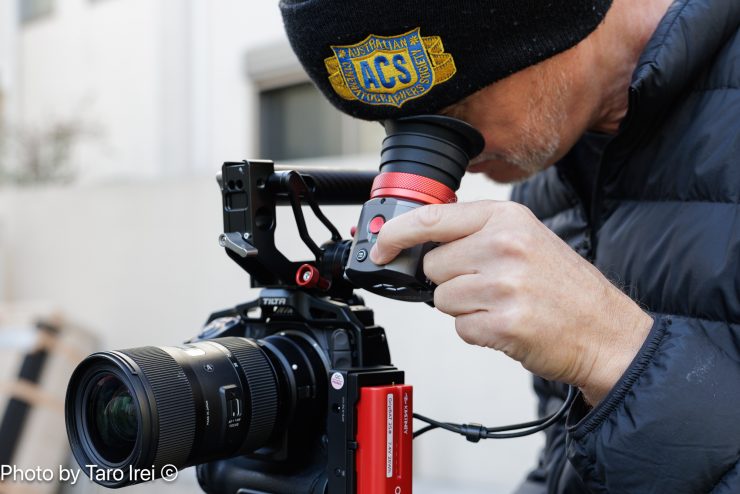
Below are the video assist functions:
| Luma Waveform |
| Desqueeze/Scaling (Anamorphic) |
| 2:1 or 4:1 Zoom In |
| Peaking |
| Histogram |
| False Color |
| Zebra |
| Safe Guides |
| Screen Markers |
| Image Rotation |
| Image Flip |
| Freeze Frame |
| Frame Lines |
| Center Marker |
| Audio Meters |
| SMPTE Color Bars |
The EVF is equipped with a comprehensive suite of software features such as Luma Waveform, Peaking, Histogram, False Color, anamorphic de-squeeze, etc.
You can assign certain tools to the 4 function buttons:
| USER BUTTON | FUNCTION |
| 1 | Peaking False Color Zebra Zoom Waveform Histogram Frame Line |
| 2 | Peaking False Color Zebra Zoom Waveform Histogram Frame Line |
| 3 | Peaking False Color Zebra Zoom Waveform Histogram Frame Line |
| RECORD | Record Waveform |
| KNOB | Counter clock Clockwise |
Support for vector scope is expected to be available through a firmware update within the year. Kinefinity is also looking into implementing EL Zone.
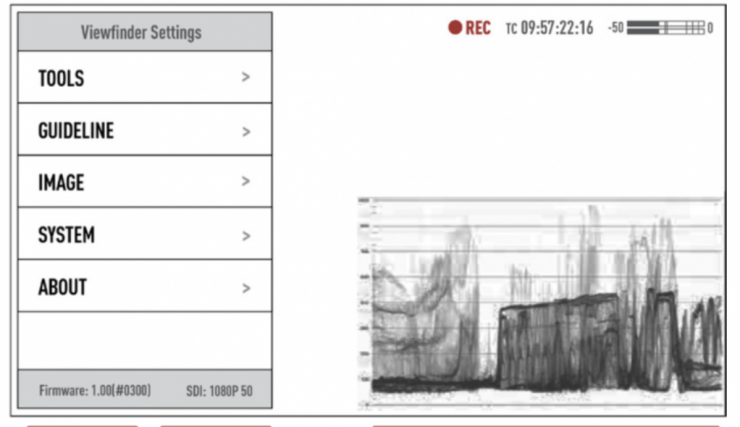
In the menu on the main operating page you have the following sub-menus you can access:
- Tools
- Guideline
- Image
- Settings
- About
Tools
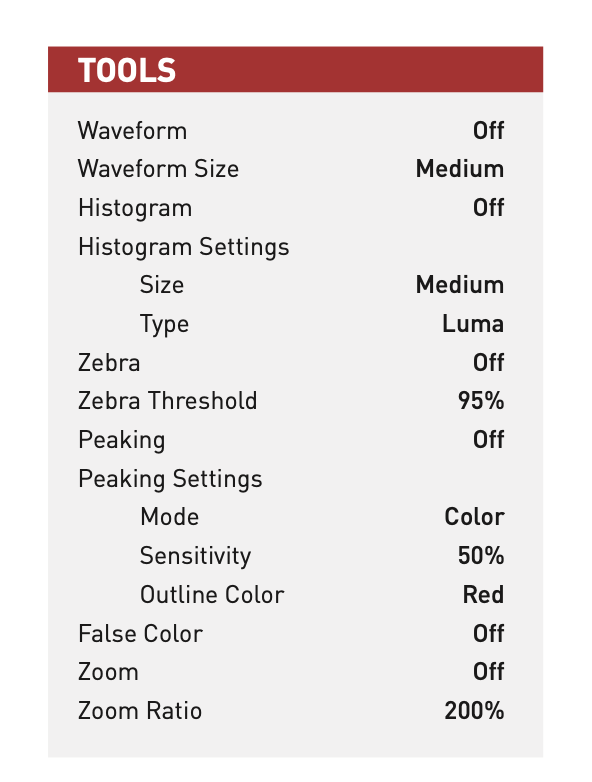
In Tools, you can do the following:
- Turn Waveform On/Off
- Change the size of the Waveform
- Turn the Histogram On/Off
- Change the Histogram settings
- Turn Zebras On/Off
- Change the Zebra Threshold
- Turn Peaking On/Off
- Change the Peaking settings
- Turn false Color On/Off
- Turn Image Zoom On/Off
- Change the level of Image Zoom magnification
You can have multiple assist tools activated at the same time.
With the Peaking you can set it to Color, Outline, or Mono. You can also change the sensitivity and the color.
With False Color, there are no adjustments you can make, and I have no idea what camera it is being mapped to. There is also no color scale showing you what the IRE values are for particular colors. When I did compare it to the EVF on my ARRI Amira side by side, the false color (despite the colors being slightly different shades) was almost identical.
With Image Zoom, you can use the scroll wheel to adjust the area you are looking at. I would have liked to have seen a box that shows you where on the image you are and some type of display icon that lets you know you are looking at a zoomed-in view of your image. I found that it was too easy to forget that this function was activated. In fairness to Kinefinity, if you do have OSD activated on your camera that is then being shown in the EVF, if you activate Image Zoom those go away. That alone may be a good enough indicator for some people to avoid confusion. When you turn the Image Zoom Off and then back On again, it will default to the center position and not where you previously set it.
What you clearly need to know is that the false color and the waveform are based on whatever signal the e-Viewfinder is receiving. So if you are sending out an image to the EVF over HDMI and you have a LUT activated, the false color and the waveform will be based on that image, not on a LOG signal.
Guideline
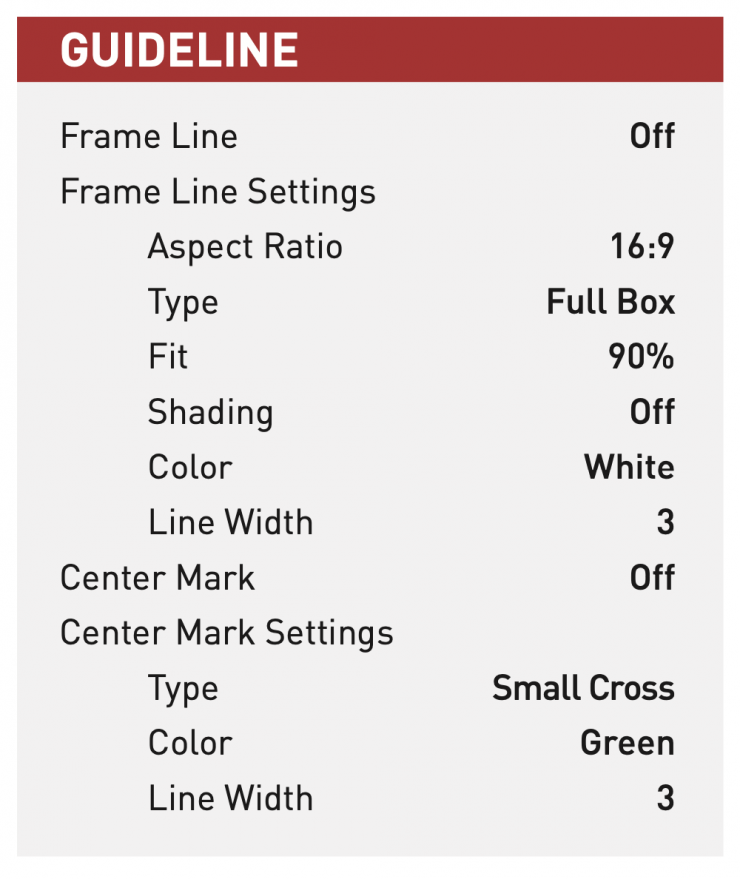
In Guideline, you can choose to do the following:
- Turn Frame Lines On/Off
- Change the Frame Line settings
- Tuen the Center Mark On/Off
- Change the Center Mark Settings
In the Frame Line settings, you change the aspect ratio to the following:
- 16:9
- 17:9
- 2:1
- 2.39:1
- 2.4:1
- 1:2
- 9:16
- 1:1
- 4:3
You can also change the thickness of the box, shading, and its color.
Image
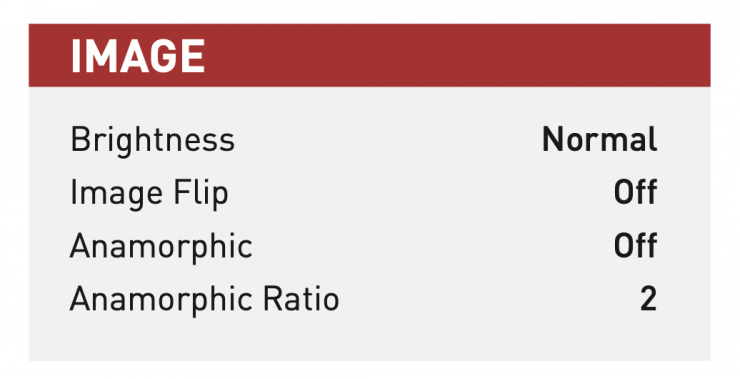
In Image, you change the following:
- Image Brightness
- Image Flip
- Anamorphic
- Anamorphic Ratio
In Anamorphic Ratio you can set the following:
- 2x
- 1.8x
- 1.75x
- 1.5x
- 1.33x
- 1.25x
Settings
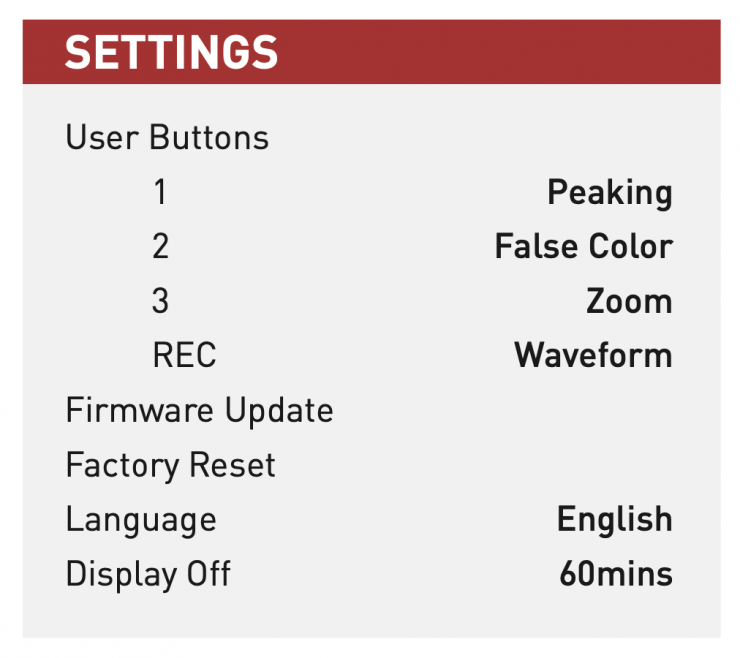
In Settings, you can change the following:
- EVF Tally On/Off
- REC Tally On/Off
- Change the function of the User Buttons
- Firmware Update
- Factory Reset
- Language
- Display Auto Off Time
About
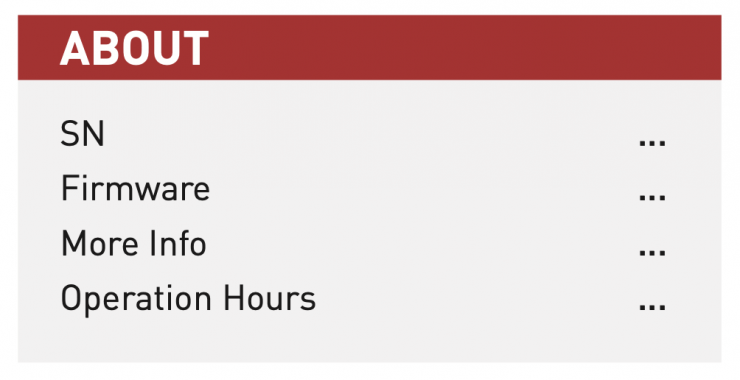
In the About section, you can see the Serial number, Firmware version, and Operating hours of the EVF.
Run/Stop trigger functionality?
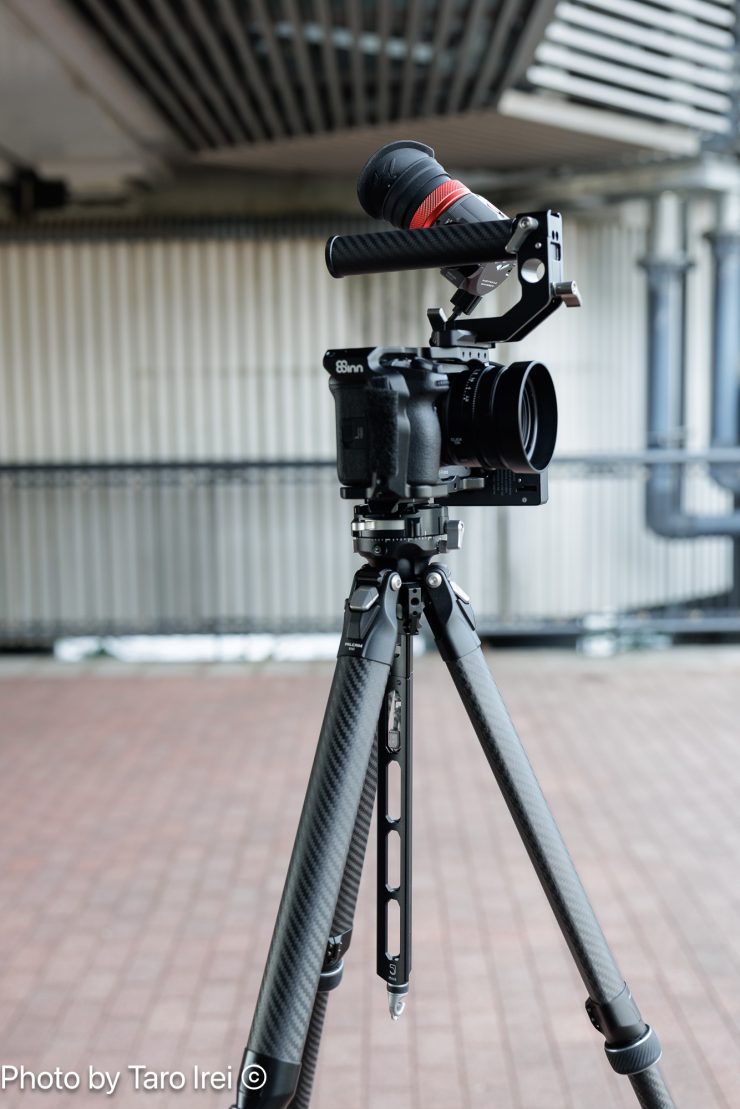
Unfortunately, the Eagle HDMI e-Viewfinder does not support Run/Stop trigger functionality.
With the latest firmware update, select Sony and Canon cameras will show if they are recording in the viewfinder display.
Can you import LUTs?
Unfortunately, the EAGLE HDMI e-Viewfinder does not support the import of 3D LUTs. Most cameras can set the LUT for HDMI monitoring separately within the camera.
What cameras would it work well on?
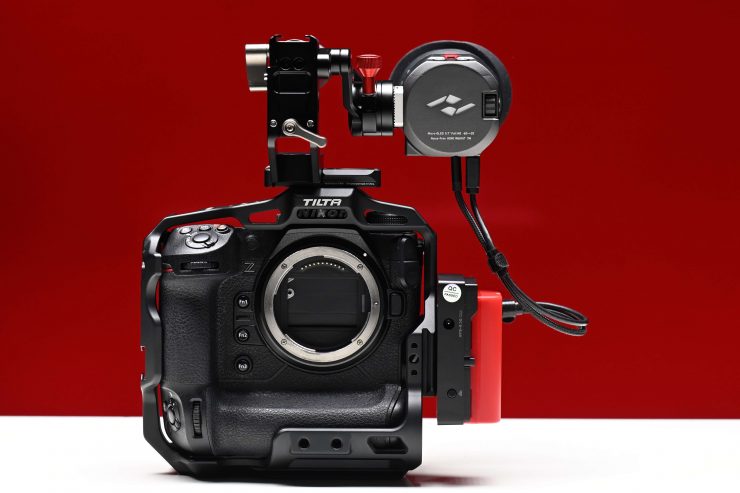
I think the Kinefinity Eagle HDMI e-Viewfinder would work well on small to mid-sized digital cinema cameras that don’t offer an EVF option or come with a loupe that goes over an LCD screen. This would include the Canon C300 Mark III, Canon C400, Canon C500 Mark II, Sony FX6, Sony FX9, Sony BURANO, some Z CAM cameras, RED KOMODO, RED KOMODO-X, etc. It would also work well with most mirrorless hybrids as long as you are running. camera cage.
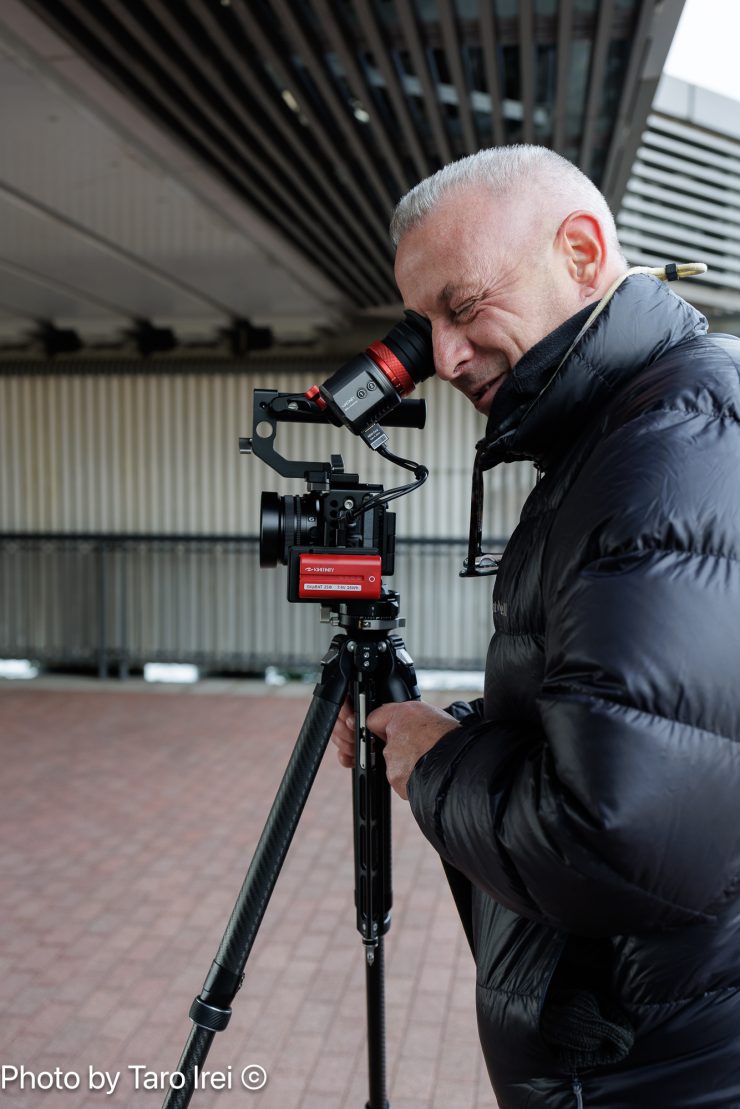
It is also a great solution for cameras like the Sony FX3 which don’t feature an EVF.
Real World Use

I am very familiar with KineEVF OLED Viewfinder which this EVF is based on and I have found it to be an excellent product when using Kinefinty cameras. The new Eagle e-Viewfinders follow in those footsteps.
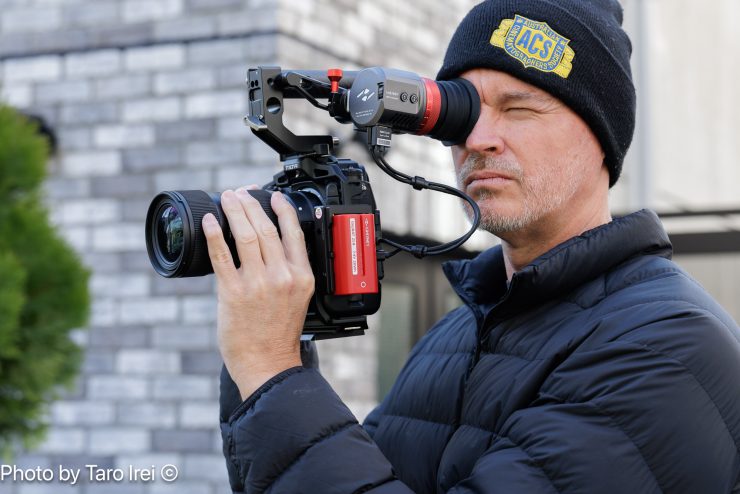
Not only does it give you a good way of stabilizing your camera when shooting handheld, but it also allows you to shoot in bright conditions outdoors and it takes significantly less real estate than a monitor.
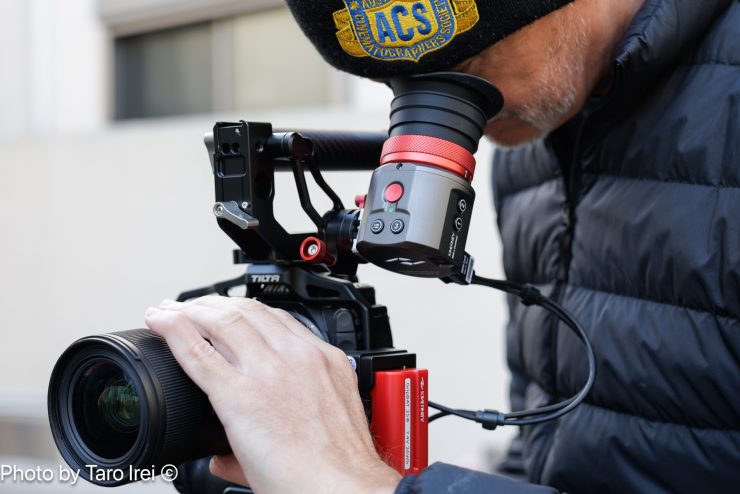
Just like the Kinefinity Eagle SDI e-Viewfinder, the Eagle HDMI e-Viewfinder is easy to use and it offers a good array of video assist functionality.
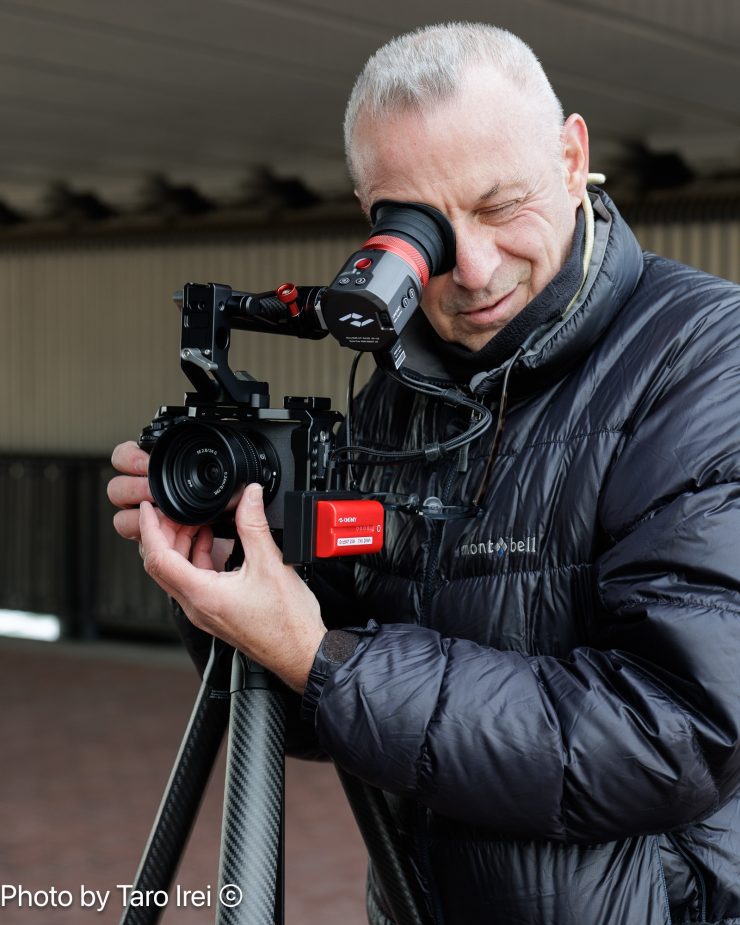
Yes, a lot of mirrorless hybrids have a built-in EVF, but that does limit how you can use the camera, especially in bright conditions.
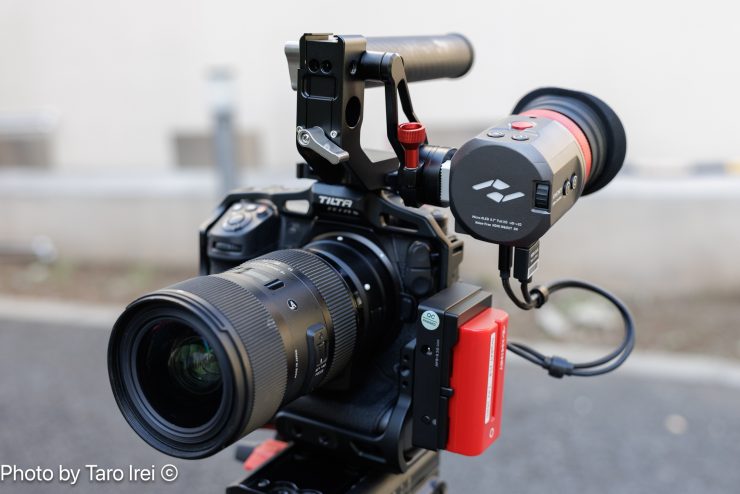
Its small size allows it to be used on a wide array of cameras, and as it has an HDMI input, it is going to be suitable for use on mirrorless hybrids.
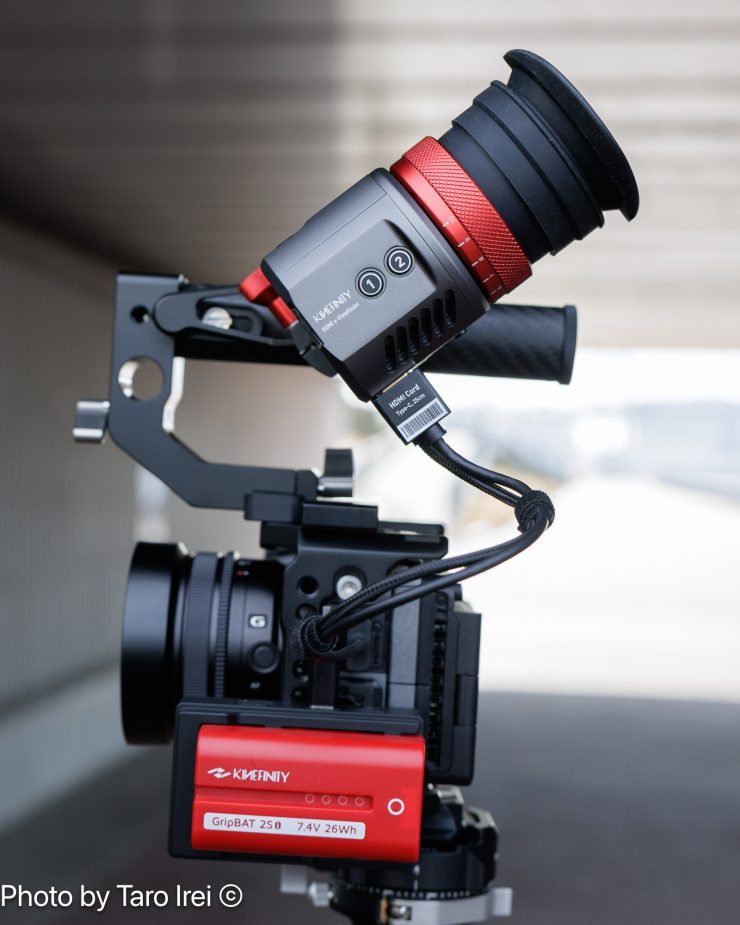
The Kinefinity Eagle HDMI e-Viewfinder is very well made, and the quality of the image and lack of any delay is great. It is good to finally see quality universal EVFs come to market, as arguably previously, the only good option was from Zacuto. These are great solutions with a well-thought-out mounting and power solution.
For their price, there is nothing better currently on the market.
Price & Availability
The Kinefinity Eagle HDMI e-Viewfinder is available in the following kits:
- EAGLE HDMI e-Viewfinder $1,199.00 USD
- EAGLE HDMI e-Viewfinder Core KIT $1,349.00 USD
- EAGLE HDMI e-Viewfinder Pro KIT $1,649.00 USD
As a reference, the EAGLE SDI e-Viewfinder retails for $1,299 USD.
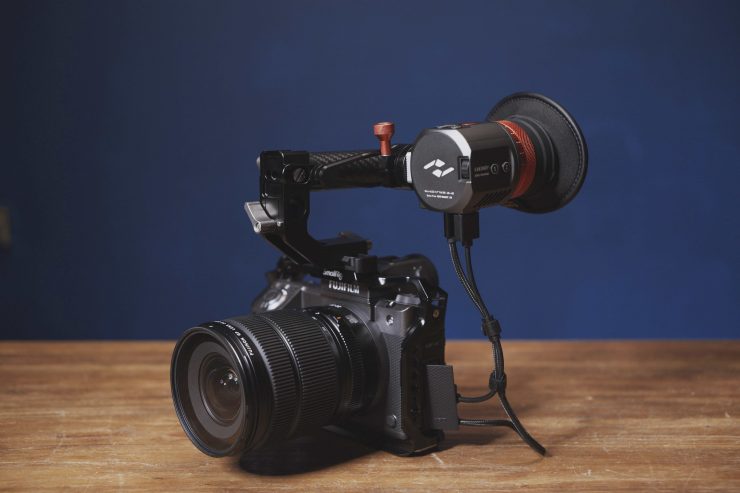
This is what you get in the kits:
EAGLE HDMI e-Viewfinder Body
- Kinefinity EAGLE HDMI e-Viewfinder x1
- E-Viewfinder Cord CH25 (Type-C, 25cm) x1
EAGLE HDMI e-Viewfinder Core KIT
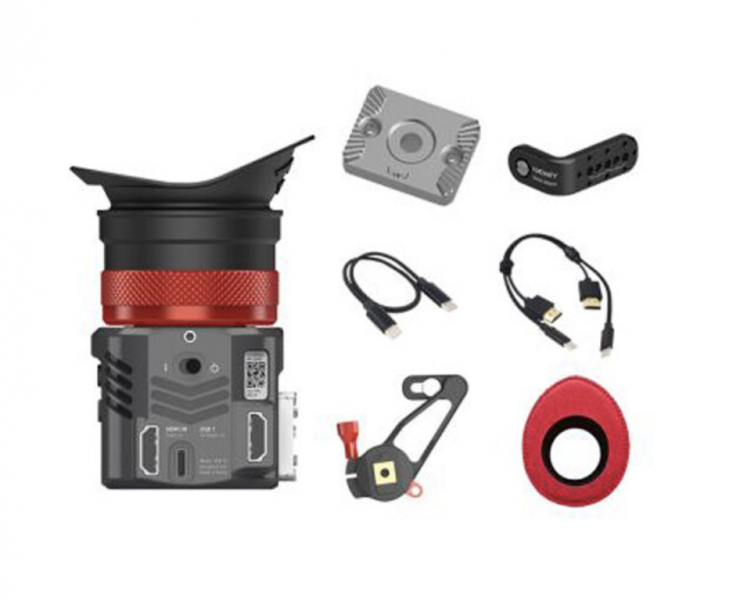
- Kinefinity EAGLE HDMI e-Viewfinder x1
- E-Viewfinder Cord CH25 (Type-C, 25cm) x1
- USB-C Cable C25 (C2C, 25cm) x1
- E-Viewfinder Mini Mount x1
- E-Viewfinder Rosette (1/4″-20) x1
- Kinefinity Bracket Adapter x1
- Accsoon Toprig Battery Plate x1
- E-Viewfinder Eye Cushion x1
- 1/4″ to 3/8″ Screw Adapter x1
EAGLE HDMI e-Viewfinder Pro KIT
- Kinefinity EAGLE HDMI e-Viewfinder x1
- E-Viewfinder Cord CH25 (Type-C, 25cm) x1
- USB-C Cable C25 (C2C, 25cm) x1
- E-Viewfinder Mini Mount x1
- E-Viewfinder Rosette (1/4″-20) x1
- Kinefinity Bracket Adapter x1
- Accsoon Toprig Battery Plate x1
- E-Viewfinder Eye Cushion x1
- 1/4″ to 3/8″ Screw Adapter x1
- E-Viewfinder Cord CH50 (Type-C, 50cm) x1
- E-Viewfinder Cord BH50 (D-Tap, 50cm)x1
- Movcam Carbon Fiber Handgrip x1
- Kinefinity NATO Rail x1
- GripBAT 2Si x2 + PD Hybrid Dual Charger Pack x1
How does this price compare to the competition? Well, below you can see.
| PRICE | |
| Kinefinity Eagle SDI e-Viewfinder | $1,299 USD |
| Zacuto Kameleon EVF Pro | $1,950 USD* |
| Z CAM 2.89″ EVF101 Electronic Viewfinder | $999 USD |
| PORTKEYS LEYE 3G-SDI & HDMI 2.4″ LCD Electronic Viewfinder | $499 USD |
| Blackmagic Design URSA Cine EVF | $1,695 USD |
*Doesn’t come with any cables or mounting components
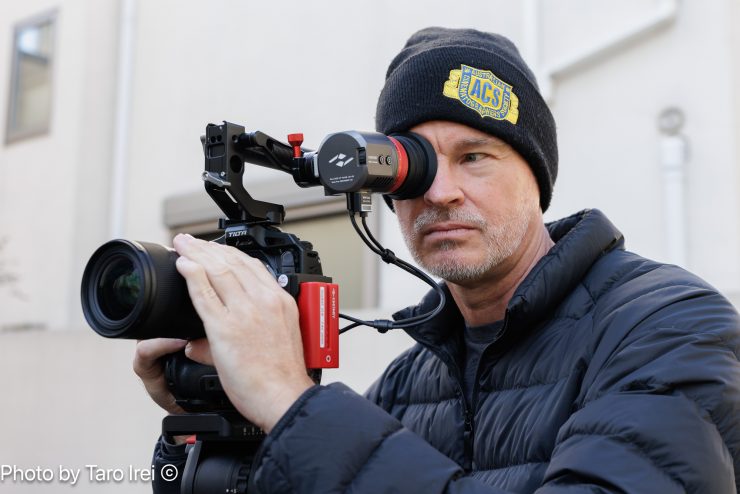
The Kinefinity Eagle HDMI e-Viewfinder is well-priced at $1,199 USD and is significantly more affordable than the Zacuto Kameleon EVF Pro which is arguably its closest competitor.
Specifications
